
































































































The lack of revenue coming from the Ithaca Tompkins International Airport will have a major impact on Tompkins County’s 2023 budget. at much was clear at the September 6 meeting of the Tompkins County Legislature. e airport has seen decreased passenger tra c due to the pandemic’s impacts on the travel industry and its slow recovery. According to Tompkins County Administrator Lisa Holmes, “passenger tra c is a signi cant source of revenue for the local airport.” In 2021 passenger tra c was at 50% of 2019 pre-pandemic levels, so it’s easy to see why the airport is seeing a decrease in revenue.
e recommended budget includes a three-year plan to assist the Airport’s
recovery, with $1.3 million in 2023. e budget also includes $342,481 to pay half of the debt service on the recent terminal project, a cost expected to recur for the next three to ve years. e airport has initiated a three-year recovery strategy to maximize revenue and reduce expenses.

Regarding the airport funding, Legislator Mike Sigler (R-Lansing) inquired as to whether the money committed by the County would be a loan to be paid back as fees are generated in the future. Holmes responded saying that the responsibility for maintaining the airport ultimately falls on the County, and while it is expected the airport will again be self-sustaining in the future this is a measure realistically meant to subsidize the department in the short term.
Sigler made the argument that the funding should come from the American Rescue Plan Act (ARPA), but Holmes responded that signi cant funds have been received by the airport through other federal programs and that the County’s funds through that program (ARPA) cannot be directly committed as the airport received other similar federal funds.
Holmes recommended a county budget for scal year 2023 that totals $207.7 million, and a capital budget that totals $121.5 million.
e median-price for a home in Tompkins County has increased from $205,000 in 2021 to $225,000 in 2022. By increasing the share of property tax revenue (tax levy) that the County receives out of the now larger pool of property taxes by 1.46%, Holmes believes owners of medianpriced homes could actually see a reduction in their County property taxes of $83.
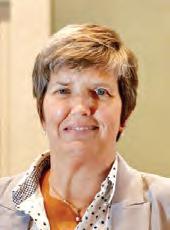

e Legislature will hear presentations from County departments detailing their budgets over the next month through the Expanded Budget Committee, an extension of the Budget, Capital, and Personnel Committee.
City Looking For Concerned Citizens — The City of Ithaca is looking for people to serve on advisory boards and committees. There are openings on the Board of Zoning Appeals http://www. cityo thaca.org/368/Board-of-Zoning-Appeals, the Cable Access Advisory Committee http://www.cityo thaca.org/369/Cable-Access-OversightCommittee, the Community Police Board http://www.cityo thaca. org/379/Community-Police-Board, the Ithaca Housing Authority http:// ithacaha.com/board-commissioners/, and the Workforce Diversity Advisory Committee http://www.cityo thaca.org/350/WorkforceDiversity-Advisory-Committee. Information about the roles and responsibilities of each board or committee is available on its webpage. If you are interested you’ll need to complete the application form at http:// lfweb.tompkins-co.org/Forms/coiBoardsCommittees. Be aware that the application form doesn’t support Chrome so you’ll need to use a di erent
browser. Appointments generally take a few months to process since the Common Council meets monthly. For more information you can call the City Clerk’s O ce at (607) 274-6570, Option 2.
Bike Donations Wanted — If you’ve got a bike that has been outgrown or isn’t being used, consider donating it to Bike Walk Tompkins. The organization is always looking to match people up with used bikes on an ongoing basis. They refurbish the bikes and put them through a safety check, and then sell them at a ordable prices, sometimes donating them to people in need. At the moment they’re speci cally looking for adult-sized bikes, hybrid, road, or mountain bikes, and bikes in working condition or near-working condition, that could be sourced back out to the community . If you’d like to donate a bike or bikes, reach out to simon@bikewalktompkins.org for information and to arrange a pick up or drop o time.
THE ENTIRE CONTENTS OF THE ITHACA TIMES ARE COPYRIGHT © 2022, BY NEWSKI INC.
All rights reserved. Events are listed free of charge in TimesTable. All copy must be received by Friday at noon. The Ithaca Times is available free of charge from various locations around Ithaca. Additional copies may be purchased from the Ithaca Times offices for $1. SUBSCRIPTIONS: $89 one year. Include check or money order and mail to the Ithaca Times, PO Box 27, Ithaca, NY 14851. ADVERTISING: Deadlines are Monday 5 p.m. for display, Tuesday at noon for classi ed. Advertisers should check their ad on publication. The Ithaca Times will not be liable for failure to publish an ad, for typographical error, or errors in publication except to the extent of the cost of the space in which the actual error appeared in the rst insertion. The publisher reserves the right to refuse advertising for any reason and to alter advertising copy or graphics deemed unacceptable for publication. The Ithaca Times is published weekly Wednesday mornings. Offices are located at 109 N. Cayuga Street, Ithaca, NY 14850 607-277-7000, FAX 607-277-1012, MAILING ADDRESS is PO Box 27, Ithaca, NY 14851. The Ithaca Times was preceded by the Ithaca New Times (1972–1978) and The Good Times Gazette (1973–1978),






Ithaca’s cinematic landscape has been changing and evolving lately. Cinemapolis Executive Director Brett Bossard is leaving the art-house non-pro t theater a er a nine-year stint, for a new gig at his alma mater Ithaca College as Executive Director of Alumni and Family Engagement. is comes on the heels of Cornell Cinema Director Mary Fessenden retiring a er 35 years. It’s been quite a long time since Bossard was an IC undergrad, coming down the hill to see “Slacker” (1991) and “Dazed and Confused” (1993) back at the old Cinemapolis in Home Dairy Alley. Bossard spoke to the Ithaca Times about the ups and downs of almost a decade in the indie lm business.
Ithaca Times: Nine years is a piece of time. Since we last spoke for Cinemapolis’s 30th anniversary in 2016, two big things that have happened since then. First there was the pandemic.

Brett Bossard: Yeah. [laughs] Yes.
IT: Can you even talk about that in the past tense?
BB: Yeah, I think we can say we’re on the other side of it.
IT: What was that whole experience like?
BB: Certainly unexpected. Nobody ever plans for that. I think it was really
COVIDencouraging how quickly the community responded, to support us and to make sure that we knew that they’d be here for us when we were able to open the doors again. Just in that rst four weeks from when we closed back in March of 2020, I think we got over a hundred new members who just immediately showered us with support and said, “We wanna make sure you stick around.” And I think it helped that we made it very clear that we were gonna keep the sta on the payroll during the closure. We’re a living-wage employer, and that was really important to me and the board, to make sure that everybody was able to remain whole during the closure. at was harrowing. It was kind of like my version of a capitol campaign for the cinema, because of other COVID relief grants, and of course, the big new operator’s grant that the Federal government made available to movie theaters and performing arts centers. It amounted to about three-quarters of a million dollars that we had to raise in the course of the 65 weeks we were closed. But who’s counting? [laughs]
IT: at was the introduction of your virtual model.
BB: Yeah, that was just a nice conuence of theaters that were willing to change the way we thought about things, and distributors, really. It was key that the indie distributors were able to be nimble and adjust practices. In many cases, these were lms that they already had plans to do a theatrical release for, and they were sorta stuck. ey had to do something with these lms, they’d acquired and paid for them and spent some money on marketing them, so they really had to nd a way to nd an audience for them. at seemed like a perfect t for keeping us going during what was a potentially very dark time for lm exhibition. [laughs]
IT: And the theater has been renovated, post-COVID.
BB: We had plans to do some renovations anyway, so we took the opportunity while we were closed to do them. We completely renovated the bathrooms, adding new hands-free xtures, a fresh coat of paint and new countertops. Just to reopen, we had to make changes in the way the ventilation in the cinema was handled, we changed the ltration. We started public screenings back up in June of 2021, and we just in the last month went back to full
capacity screenings. at was more than a year of operating with limits in place.
IT: e other big change is that for the rst time, movies can play at Regal and Cinemapolis. What has it been like, factoring more mainstream titles like “Elvis” and “Nope” into the mix?
BB: I think the industry has just changed immensely, particularly since the pandemic, but even before that. Many distributors were doing away with what they called “zone clearances” for their lms, so they were booking lms at any theater that would buy them, basically. Films like “Nope” and “Elvis” and “ ree ousand Years of Longing” t our audience, and we can provide an opportunity for our audience to see a lm without going up the hill. We’re not creating a danger for Regal, let’s put it that way.
IT: What were some big recent hits?
BB: Well, certainly “Everything Everywhere All at Once” was a tremendous success for us. We opened it in early April, and we played it for 15 or 16 weeks. Now, granted, in other metropolitan areas in upstate New York, they have multiple movie theaters that would have been playing that lm, but pretty much from Syracuse to Bu alo, Cinemapolis was the top-selling theater for that lm. We sold more tickets than anyone else. It hit a lot of sweet spots, both students and otherwise. I thought it was a great movie, and to see it accepted with such fervor among our audience was really gratifying.
WHAT IS THE MOST UNEXPECTED TURN YOUR LIFE
“Met my best friend when my car broke down”
– Romana W.
“Never expected to get a job as a professional dancer in India” – Heather M. “My new job” – Caeln H.
“Having my daughter; it set me on a path of my passion” – Lexie S.
“Going to trade school and not an Ivy league” – Sarah C.Bossard believes that Cinemapolis now being able to show some of the same films as Regal will be a boon for downtown. (Photo: Josh Baldo) Cinemapolis has had to cope with the extensive construction around it, making entry to the theatre an adventure at times. (Photo: Josh Baldo)
Tompkins County o cials, surprised by claims made in a press release from the environmental watchdog group Seneca Lake Guardian (SLG), reached out to the group to clear up their concerns and then joined the group in criticizing the New York State Department of Environmental Conservation’s (DEC) issuance of a permit based on faulty information.
SLG recently put out a statement saying that the DEC ignored its own regulations by authorizing County Line Materials Recovery Facility, a waste transfer facility to be built in Cayuta in Schuyler County, to transfer 30,000 gallons of contaminated water — otherwise known as leachate — per year to the Ithaca facility.
Chair of the Ithaca Area Wastewater Treatment Facility (IAWWTF) Special Joint Committee, Cynthia Brock responded to these claims saying, “ e DEC did approve the permit, and the Seneca Lake Guardian and their attorney Earth Justice is ling an article 78 to challenge the permit.”

SLG says that all of these leachates contain carcinogenic PFAS and there are currently no regulated ways to remove PFAS. erefore, they should not be adding to creating new sources of PFAS that might discharge into the lake.
According to Brock, “I think they’re saying about 80 gallons a day could be transferred. But keep in mind that [IAWWTF] treats 6.5 million gallons a day. ey’ll probably wait until they ll a truck, they won’t be just transferring 80 gallons at a time. But even a truckload of this sort of water is not a signi cant volume for what we treat on a daily basis.”
Additionally, Brock said that the IAWWTF is not permitted to treat industrial wastewater and that all industrial users are required to comply with industrial pretreatment standards and extensive technical review prior to releasing into the IAWWTF as set forth in the City’s State Pollutant Discharge Elimination System (SPDES) permit.

e Acting Assistant Superintendent of Water and Sewer for the City of Ithaca,
Scott Gibson, also said that “we simply cannot accept a waste stream that will cause harm to the treatment plant or cause a violation of our discharge permit.” He continued saying, “Haulers are issued approval only a er a rigorous testing schematic.”
e IAWWTF collects wastewater from a wide array of sources such as sewage, waste from dairy farms, land lls, porta potties, and more. Brock says that “the facility tests everything to make sure that it is within the limits that we are approved to receive, and then if it is within those limits, we treat it to remove those contaminants.”
According to an SLG press release, “In its permit application, County Line described how it will handle the incoming waste and outgoing wastewater. e facility will accept municipal and commercial garbage, construction and demolition debris.” is debris contains PFAS, which exist in nearly everything manufactured. PFAS, otherwise known as per- and poly- oral alkyl substances, are chemicals that are known to be hazardous to human health and are a major cause of cancer.
During the water treatment process, liquids are separated from the waste material and create leachate. is leachate is contaminated by the PFAS that existed within the materials it was separated from. According to SLG, this leachate has been authorized to be transported from the County Line facility to the IAWWTF, where it will then be discharged into Cayuga Lake.
According to the president of SLG, Joseph Campbell, on June 15 the DEC granted County Line clearance to receive up to 500 tons a day of municipal wastes and other materials at its 7.49-acre site on Route 13 about one mile east of Alpine Junction in Cayuta.
e vice president of SLG, Yvonne Taylor, recently said, “DEC ignored that County Line is a likely source of PFAS and

issued an operating permit anyway. We plan to challenge DEC’s decision while remaining vigilant in partnership with the treatment facility in an e ort to protect our drinking water.”
However, Scott Gibson says that SLG’s claims that PFAS contaminated leachate is being released into Cayuga Lake isn’t entirely accurate. According to Gibson, “many PFAS are actually removed in the sludge management process.” He continued saying that “PFAS become bound to solids which are then sent to a press to remove water and shipped to a land ll for disposal.”
From there, the land ll produces leachate as rain water and other liquids move through the material and that leachate is then transported back to the treatment facility for further processing. Gibson says, “ is is not to say that all PFAS are removed but to suggest that they are blowing out into the lake untreated is simply untrue.”
e impact of forever chemicals like PFAS is an emerging issue that the EPA and DEC are just beginning to take seriously. ese compounds exist in all waste streams, including private homes, collection systems, septage receiving and leachate. However, there are currently no wastewater testing requirements for PFAS.
Assembly Member Anna Kelles of the 125th District, in response to the confusion and the potential threat to drinking water said that “Exposure to toxic forever chemicals known as PFAS is a growing issue that threatens the drinking water of New Yorkers across the State. I’m glad that Seneca Lake Guardian will ght to reverse DEC’s lackluster decision to issue a permit that erroneously directs these chemicals to go to a wastewater facility that is not per-
To the County for doing what it can to support the airport. We need a thriving air hub to remain a vital community.

To people who are leaving their household trash along downtown streets. A trash tag really doesn’t cost that much.
People aren’t ready to start talking about local elections yet. They want a break and a respite from the turmoil of the rest of the world.
It looks like Ithaca is returning to what passes for normal. Downtown seems more crowded. Performances have bigger audiences. People walking around just appear more upbeat.
IF YOU CARE TO RESPOND to something in this column, or suggest your own praise or blame, write news@ithacatimes. com, with a subject head “U&D.”



What’s the biggest issue facing Ithaca right now? 35.3% Affordable housing. High rents are driving working people out of the City. 61.8% Crime and policing. Can we reimagine policing AND keep the City safe? 2.9% Homelessness. How do we balance the needs of the unhoused and property owners? N
With COVID receding will you shop locally and in-person more?
Visit ithaca.com to submit your response.
Anarrative of genocide and displacement: that’s the first—and until recently, only—story that most people hear about the inhabitants of the lands surrounding Cayuga Lake prior to European colonization. Knowledge about the Gayogo hó:nǫˀ (pronounced “guy-oh-KHOH-no”, and also known as “Cayuga”) people who lived in this region for thousands of years is too often summarized by roadside “historical” markers that catalog a few days of the scorched-earth campaign of Washington’s troops in late September of 1779, as they burned villages and crops in their attempt to drive out Indigenous people. Carrying few physical items other than treasured seeds, and holding tight to their language and traditions, Gayogo hó:nǫˀ families fled to Ohio, Canada, and western New York; later, some moved to the Oklahoma territories. Facing starvation and a bitterly cold winter ahead, many lost their lives during the initial exodus.


All most people know of the original inhabitants of this area comes from historical markers commemorating their destruction. (Photo: File)

is tragedy, however, along with the continuing trauma of diaspora and disenfranchisement, is not an endpoint in the story of the Gayogohó:nǫˀ people, although the simpli ed road signs might make you assume this is the case.
Descendants of these courageous and resilient people have survived, and with them, so have cultural identity, language, and foodways. e Gayogohó:nǫˀ people
Adearth of downtown parking was disconcerting one recent night before realizing that a concert was the reason: a big show at the State eater. en the mild annoyance became, instead, reason to be glad. A er more than two years of viral standstill, the world is stirring again.
Of course, concerning the virus, it ain’t over till it’s over, and it ain’t over. e State eater has crowds, but so do drug stores giving booster shots.
But it’s good the crowds are beginning to tilt. In anticipation, the State eater has a full slate of good shows scheduled.
September is traditionally known as “the season,” or the start of it each year, in the worlds of art, culture and entertainment. Check the Arts and Leisure section of the New York Times on Sundays in August, and then in September, and you will notice a substantial increase in page count, with previews, reviews, announcements and ads for new shows, activities and exhibits of all kinds.
At 1,500 seats, the State eater is a major concert venue in central New York. Cornell University presents concerts, but tends not to publicize them much o campus, and the acts tend to skew toward a college audience rather than a wider one.
Shows presented at Cornell are generally in halls primarily meant for lectures, classes and athletics. e State is a real, vintage theater, with elaborate, oldfashioned decor, Byzantine and busy. e seats have red fabric, of course. e massive curtains are maroon.
e State was a movie theater until a time when such large houses became untenable. For a few years it was recon gured with two screens, with the balcony walled o as a second theater, but that wasn’t pro table either. It sat vacant a few years until community activists brought it back for live shows. (It should be noted that this brief recap passes over, with apologies and respect, years of strenuous revival e orts by a great number of dedicated citizens and businesses.)
A special energy exudes from such a magni cent old showcase in the heart of a modern town. ere are no dedicated parking lots; performers’ tour buses sit out front, on the street. Stage doors open to the sidewalk.
Between a ernoon set-ups and evening performances the players might stroll downtown, visiting the record store, gui-
tar shop, book stores, food markets, cafes and restaurants.
Sometimes there are antics. One of the rst important shows at the newly revived State in the ‘90s was Ani DiFranco. She had played as a relative unknown at the GrassRoots Festival a few years before and developed a regional following (she is from Bu alo), but in short time her career took a rapid turn to massive popularity.
It promised to be a big night for the State, until it developed that Patty Larkin, a more established artist with a similar fanbase, was scheduled to play the same night at a theater two blocks away. It was a smaller theater, but it threatened to divert interest from Ani’s show, and maybe hundreds of ticket sales.
e smaller theater might easily sell out, but the State had a thousand more seats to ll. ere was gnawing worry at the State up until the a ernoon of the show, when a sta er coming in reported a stirring sight outside: hundreds of fans lining up on the street, three or four hours before showtime. e show was general admission and they were arriving early - extremely early - to get good seats. e box o ce checked ticket sales. In those less automated days, such information was less readily retrieved. e numbers indicated that the show might sell out, competition or no. e crowd outside indicated it would be powerful.
Someone went to get Ani. “You have to see this,” they said. “ ere’s a line going around the block.”
Curious, a bit incredulous, Ani went to a stage door that opened to the street. She peeked out just a crack, not to be seen. But to get the full scope she had to emerge, and nally did.
She tried to be furtive, but it didn’t quite work, and she was spied. en the incredulity was from the crowd, but people stayed cool: some gasps, but no signs of grasping.
With that Ani felt comfortable enough to come out. She stood with her hands on her hips and addressed the crowd.
“Hey, what’s the matter?” she shouted. She looked up and down the block. “Couldn’t you people get tickets to see Patty Larkin?”
e crowd was too addled to laugh, but Ani did. “Well, don’t worry,” she said. “We’ll do a few of her songs.”
A er many years Ani is back in Ithaca for a show November 8, making music and memories; maybe covering Patty Larkin, who knows. e State eater, of course, is the scene.
Ithought the algorithm goblins were at work. Last week’s column pointed out that I am 30 years into my tenure as the Ithaca Times sports guy, and when I was looking for a story idea for this week, who should pop up, but Bob Congdon, about whom I started writing...you guessed it...30 years ago.
Back then, I wrote about Bob’s impressive streak of twenty-some consecutive Boston Marathons (he would run many more), and this week I saw that he was one of the loyal runners taking part in the iconic Ithaca 5&10, described on the Finger Lakes Runners Club’s website as “Ithaca’s oldest foot race.” I asked Gary McCheyne—this year’s Race Director—just how long the event had been in existence, and he said, “ is was our 45th year. We took a couple of years o , but this was year number 45.”
McCheyne—who has directed or co-directed the race for 10 years— rst ran the 5 &10 in 1978, back when those numbers represented miles rather than kilometers. I was not aware of the switch, so when I asked him who won the races, and he said, “the winning times were 32:06 for the 10 and 16:40 for the 5,” I thought a pair of world records had been set. In Gary’s words, “It just got too hard to get volunteers for the longer races.” He was quick to add, “ is year, we had 47 volunteers, and I really appreciate them all. Without them we can’t put on the races.”
is year’s eld of 168 runners (and 15 in the kids’ Fun Run) ranged in age from 10 to well over 70, and McCheyne said, “Every year, they come out of the woodwork.” e runners were treated to a cool morning with a light rain (“runner’s weather,” in McCheyne’s words), and the route starts at Ithaca High School, runs down to Court Street, back up Tioga to Fall Creek, back up Lake Street. Years ago, a loop around Stewart Park was included, but when the race was shortened due to the di culty of getting enough volunteers, that part was scratched.
Gary was impressed that the eld was so well-populated, given the full running schedule in the region. “Our race was just one of three events,” he o ered. “Sunday
Henry Williams finishes first in the 10K portion of the Ithaca 5&10.

also saw the Virgil 100-Mile Ultra and the start of the N.Y.S. Adult Cross Country season. A lot of people that would have normally been at the 5 & 10 were competing in those races.”
Once again, I tracked down Bob Congdon and he said that he didn’t run as well as he wanted to, but that he was pleased to keep his streak going. He has run every one of the 45 Ithaca 5 & 10s, and he is also a member of the exclusive Boston Marathon Quarter Century Club. He told me, “I ran Boston forty times—thirty consecutive—and that got me into the club.” Looking back, Bob said, “I was one of the race’s (the Ithaca 5 & 10) originators, and Jim Hartshorne got involved as Race Director. He knew how to run things.” As area runners know, when Jim got involved with something, it was done properly, and the race’s longevity would make him proud, for sure.
Steve Ryan is another longtime local road warrior, and he—at age 71— nished second in the Over-60 division. Bob hu ed a little at having to compete with a youngster such as Ryan, as he laughed and stated that he would prefer an Over75 age group, given he is now 77. Bob implied—of course—that he would run faster next year.
● ● ●
A couple of columns back, I wrote about the upcoming Friday Night Fights at GIAC, but I regret to inform readers that this Friday’s event has been postponed. Balancing the schedules of numerous ghters is a challenge, and the organizers need more time to make it happen. Stay tuned at GIAC’s website (www. cityo thaca.org/327/Greater-Ithaca-Activities-Center) or call the agency at 607-2723622 for updates.

Earlier this morning [September 2] Ithaca Police O cers responded to another terrible situation that unfolded on the Ithaca Commons, a call for help involving a member of our community experiencing a mental health crisis. is incident was hastily reported on by Ithaca Times reporter Matt Dougherty on Twitter.
Why does the Ithaca Times and Matt Dougherty continue to choose division over community healing, partnership, collaboration, respect and understanding? Mr. Dougherty and the Ithaca Times said everything they wanted to in the rst paragraph of their story titled “Mental Health Issue on the Ithaca Commons”. “Around 9:30 a.m. on September 2, IPD responded to a mental health incident near the Ithaca Commons. Several o cers, including a K9 unit, entered an apartment above the Ithaca Times building and proceeded to taze the suspect multiple times.”
ey should have just stopped there. e Ithaca Times could have taken this opportunity to use their platform for something constructive to bring our broken and struggling Ithaca community together. Matt Dougherty could have highlighted how in many cases, those su ering from mental health issues in our community remain unsupported and on their own, failed by the system. He could have done research and reported multiple perspectives on the issue from people who can o er solutions.
e Ithaca Times could have waited for a factually based statement from the Ithaca Police Department to fully understand the context of the situation this morning. ey could have highlighted another dangerous critical incident on the Ithaca Commons brought to a peaceful

resolution by the hardworking men and women of the unsupported and crumbling Ithaca Police Department. Despite everything, these same O cers continue to show up and put themselves in harm’s way for our community and our safety. Ultimately Mr. Dougherty decided instead to use this unfortunate situation where Ithaca Police O cers were responding to a call for help so he could further divide our community and paint our public servants in a poor light. e person who was the subject of the call for help this morning, likely experiencing their worst day, was also unfairly criminalized by Matt Dougherty who referred to them as a “suspect” without even considering the underlying reasons for their behavior. is article was a blatant and shameful attempt by the Ithaca Times to continue to marginalize our police o cers from the community while also harshly degrading a person in crisis. is is extremely disappointing; Matt Dougherty and the Ithaca Times should be ashamed.
e continued attempts by the local media to divide our community and misrepresent Ithaca Police O cers with no understanding of the dangerous work they do or those who they frequently interact with and assist must stop immediately. We need to come together now and focus on solutions, not politics and the past. We must choose healing over hate.
omas W. Condzella President, Ithaca Police Benevolent Association
Editor’s Note: e Ithaca Times stands behind our story and our reporter.
In an area that has some of the most beautiful parks in the world, why is it that the bathrooms are such crap? ere are so many wonderful people living around the Finger Lakes area. I’m certain folks would donate their time to paint rusty doors and brush away cobwebs. Perhaps stores would supply paint, brushes, etc. and write it o as a donation. Next time you are in Taughannock, Cass, and Myers, be a “four usher” and check out all the facilities.
Cindy Schachner Margolis, IthacaWhen the City of Ithaca set out to reimagine public safety two years ago, building a better relationship between residents and police was the top priority. As part of that e ort the Ithaca Police Department developed an online data dashboard and gave the public access to it on June 8.
In a statement released to the media, Acting IPD Chief John Joly said, “ ere is a ton of information available here and we are excited to share this with the public.” He continued saying, “...it’s just to be transparent, we wanted to be able to provide the citizens with a window into what happens, what the Ithaca Police Department is doing, and what their tax dollars are paying for.” However, he also said that “it’s important for people to understand the limitations of our resources.”
e dashboard can be found on the City of Ithaca website at https://www.cityo thaca.org/752/Community-Dashboard and includes up to date information about police calls, responses, and arrests going as far back as 2019. e dashboard also provides the public with information regarding the number of o cers that respond to a scene. According to Joly, the number of ofcers responding to an average call is down as a result of sta ng shortages. e information can be ltered by year, location and call type and is updated on a weekly basis, every Tuesday at midnight.

e dashboard is designed to increase community oversight of IPD and will allow community members to gain an understanding of the types of calls IPD responds to as well as the volume of calls. It also provides information about where calls are coming from and how many of those calls result in arrests.
At the time of writing, the dashboard indicates that since January 2022 there have
been 13,490 total calls made to IPD and 496 of them–or 3.7%–have resulted in arrests being made. e overwhelming majority of calls, which according to the dashboard is 96.3%, do not result in arrests being made.
e most common response locations have been at the Ithaca Arthaus, West Village apartments, Walmart, 7 Eleven, Cayuga Gardens Apartments, Wegmans, the St. Johns Center and the Ithaca Commons. While arrests aren’t made o en, the majority occur at Walmart followed by 7Eleven, Ithaca Arthaus, Wegmans Grocery, West Village Apts, and the Dandy Mini Mart.
IPD Sergeant Mary Orsaio, who presented the dashboard to the Common Council’s Reimagining Special Committee,
explained that when the Ithaca Police Department is listed as a response location, as it is in the largest number of calls (764), it is because the call was made to the IPD or someone physically came into the IPD.
Orsaio said the data shown on the dashboard is compiled from IPD’s InTime timekeeping so ware and its Spillman records management so ware and is operated using Microso Power BI. Orsaio also noted that there are roll over help boxes and a tutorial video available to help citizens understand how to access data.
e dashboard does not, at present, o er a mapping feature. e Ithaca Times has taken the data from the dashboard and created a map of the top locations for calls and arrests.
When you explore the IPD Dashboard the ways calls are described might be confusing. Here’s a guide to what those terms mean, based on the original report prepared by the Reimagining Public Safety Working Group. ese are not an exact match for the Call Types used in the IPD’s Dashboard, but they provide enough information to help understand what the terms in the dashboard mean.
• Assault: Calls related to the unlawful attack by one person upon another.
• Assisting another Gov. Resource: Calls relating to assisting another agency or resource.
• Bomb reat: Calls related to a threat to bomb.
• Burglary: Calls related to the unlawful entry into a building or other structure with the intent to commit a the .
• Cardiac Arrest: Calls related to a person experiencing reported cardiac arrest.
• Child Abuse: Calls related to the act of willful harm to a child.
• Civil Complaint: Calls that relate to complaints not criminal in nature.
• Criminal Mischief: Calls related to the destruction of property.
• Dead Body: Calls relating to the scene of death; di ers depending on whether medical attention or CSI (crime scene investigation) is needed.
• Disorderly Conduct: Calls relating to public activity or behavior that's o ensive or disruptive and interrupts other people's ability to enjoy a public space.
• Dispute: Calls to investigate a dispute between individuals.
• Domestic: Calls related to disturbances or assaults involving adult members of a domestic relationship.
• Drugs: Calls related to illegal narcotics.
• Fraud: Calls related to the use of deceit to induce an entity to part with something of value or to surrender a legal right.
• Harassment: Calls related to reports of being the subject of ongoing unwanted contacts.
• Intoxication: Calls related to intoxicated individual(s).
• Local Law: Calls relating to municipal code violations.
• Missing Person: Calls relating to missing person reports.
• Noise Complaint: Calls relating to excessive or bothersome noise.
• Parking Problem: Calls related to illegal or hazardous parking.
• Personal Injury Accident: Calls related to a vehicle collision in which someone is injured as a result.
• Property Check: Calls to check a property for signs of break in while the owners are not present.
2022 Totals As of September 11 13,490 calls 496 arrests
1. Ithaca Commons 128 calls, 0 arrests

2. Seneca Street Parking Garage 84 calls, 0 arrests
3. Chanticleer 25 calls, 5 arrests
4. 7 Eleven 195 calls, 30 arrests
5. Cayuga Addiction Recovery Services 38 calls, 7 arrests
6. 210 Hancock Street Apartments 44 calls, 6 arrests
7. Chuck’s Gas Mart 59 calls, 7 arrests
8. St. John’s Center 147 calls, 9 arrests
9. Dandy Mini Mart 76 calls, 11 arrests
10. Cayuga Garden Apartments 178 calls, 7 arrests
11. Ithaca Arthaus 416 calls, 25 arrests
12. West Village Apartments 405 calls, 16 arrests
13. Wegmans 161 calls, 18 arrests
14. 200 block of Fair Street 22 calls, 4 arrests
15. Northside Wine & Spirits 22 calls, 7 arrests
16. Walmart 252 calls, 44 arrests
17. Byrne Dairy 96 calls, 6 arrests
18. Stewart Park (not shown due to scale) 122 calls, 0 arrests
• Property Complaint: Calls relating to complaints regarding private property.
• Psychiatric: Calls related to mental health.
• Public Health Complaint: Calls related to a public health related event.
• Robbery: Calls related to the taking or attempt to take anything of value from the control, custody, or care of another person by force or intimidation.
• Sex O ense: Calls related to any sexual act directed against another person, without the consent of the victim, including instances where the victim is in-
capable of giving consent or reports of unlawful, non-forcible sexual intercourse.
• Shots Fired: Calls related to reports of hearing gunshots with no indication of a victim.
• Suspicious: Calls related to reports of suspicious persons, vehicles, or circumstances.
• e : Calls related to the unlawful taking of property from the possession of another entity.
• Traumatic Injury: Calls related to reported injured person.
• Trespassing: Calls to investigate a person unlawfully on another's property.
• Unsecured Premise: Calls related to investigating a premise with an unsecured door or window.
• Warrant: Calls related to court issued warrants.
• Weapons: Calls related to weapons, people being in the possession of or a found weapon.
• Welfare Check: Calls related to requests to check on the health or safety of a subject.
mitted or allowed to accept industrial waste in the rst place, protecting the drinking water sources of Ithaca residents. We must continue this kind of work across the State.”
According to Brock, “New York State is in the process of trying to come up with ways to regulate and set standards for PFAS and PFOA’s,” but the DEC or EPA has yet to act. Brock continued saying, “I think it’s coming soon, but it doesn’t exist yet. So to claim that the wastewater treatment plant is somehow negligent or irresponsible was unnecessarily alarmist because [IAWWTF] does everything we can to make sure that we remove contaminants to the utmost extent.”
Brock added that “there are sure to be [PFAS] testing requirements in the future. We want to assure residents that the IAWWTF has and will continue to engage in rigorous testing and compliance with the law to protect Cayuga Lake as a high-quality drinking water source that people can feel con dent about.”
Brock also said that one of the bene ts of the IAWWTF is that it has a longstanding partnership to do research on emergent contaminants with Cornell University and Ithaca College. “We were in the forefront in the push against microplastics in the water and trying to remove microplastics from our waste stream. So we have always been very aggressive in researching these things.”

and their language are richly tied to the landscape from which they sprang, here in what we know as the Finger Lakes region. Embedded in this language structure itself are profound lessons about relationships with the natural world, and guidance for responsible and gratitude- lled stewardship of our environment.
Alarmingly, Gayogohó:nǫˀ language is now designated as critically endangered by UNESCO, the United Nations Educational, Scienti c and Cultural Organization. Fewer than a dozen people survive today whose rst language is Gayogohó:nǫˀ–and only one lives in the traditional Gayogohó:nǫˀ homelands in New York State. Nonetheless, many more are now learning to speak Gayogohó:nǫˀ and are working towards its revitalization and spread.
The Gayogo hó:nǫˀ Learning Project is a fiscally-sponsored project of the Center for Transformative Action, based in Ithaca. The Project offers place-based Gayogo hó:nǫˀ culture and language classes taught by a first-language speaker. Year-round classes are offered virtually to reach
the Gayogo hó:nǫˀ diaspora throughout the US and Canada, and are also presented locally to familiarize nonGayogo hó:nǫˀ people with the language and perspectives of the First Peoples of this land. Fees from locally-presented classes help support the Gayogo hó:nǫˀ Learning Project’s main mission: to support Gayogo hó:nǫˀ language revitalization efforts that are rooted in ancestral Gayogo hó:nǫˀ lands and to serve as a politically neutral meeting point for Gayogo hó:nǫˀ people wanting to learn more about their language, culture and ancestral lands.
People and culture thrive when language and connection to place stay alive. Remember that highway historical markers only tell the stories of those who erected the signs. Gayogo hó:nǫˀ culture and language persist right here in the Finger Lakes Region, through language study, perspective, and in relationship with the landscape.
For more information about attending Gayogohó:nǫˀ culture and language classes or becoming a part of the Gayogohó:nǫˀ Learning Project’s crucial language revitalization e orts, visit https://gayogohono-learning-project.org/. e next session of local in-person classes starts September 28.










Cayuga Lake is a birding mecca for those in the know. Visitors with an interest in all things avian may make the Cornell Lab of Ornithology (159 Sapsucker Woods Road, https:// www.birds.cornell.edu/home) their rst stop—with good reason since it is a worldrenowned facility and a great day trip on its own—but local birders know there are a dozen other incredible sites circling Cayuga that o er opportunities to see a large variety of migratory, breeding, and nesting birds, every season. Here are the twelve must-go spots for birding around Cayuga Lake this fall. We’ll start in Ithaca and make our way up the east side of the lake and then down the west side. One quick note before we start o : many of these sites have information kiosks where you can obtain more birding information than we’re able to provide here.
ere are lots of reasons to visit Stewart Park, but for birders its lakeshore and the outlet of Fall Creek are great places to see migratory waterfall. Check out Renwick Woods and the Fuertes Natural Area for Songbirds and smaller Birds of Prey. e pond just east of Fuertes is popular with common geese and ducks. And don’t leave without scanning the southwest side of Fall Creek for large ocks of nesting Double-crested Cormorant. In fall, you’re apt to see Brant, Green Heron, Ruddy Duck, and those Double-crested Cormorant.
is next stop is just a short stroll up the lakeshore from Stewart Park. What makes it di erent than Stewart Park is that it o ers better views west across the lake, giving you a chance to see large ocks of seasonal migrations. In fall you can hope to see Black Scoter, Great Black-backed Gull, Hooded Merganser, and Ring-billed Gull.
e highlight here is the outlet of Salmon Creek where you can look westward over the lake for waterfowl and migrations. e Salt Point Natural Area’s trails o er opportunities to see Songbirds and Birds of Prey. Historically there have been Osprey nests in the vicinity. Fall will o er chances to see American Coot, Carolina Wren, Redtailed Hawk, and Turkey Vulture.
e whole shoreline o ers spots to see Waterfowl and migratory birds, but focus on the point near the marina which gives a great panoramic vista. e trails east of the main road will give you opportunities to spot Songbirds, woodpeckers, and owls. In fall, you might see American Kestrel, Northern Flicker, Short-eared Owl, and Yellow-rumped Warbler.
Both North and South Pond are springfed, and as a result, don’t freeze in the winter, making them prime spots. Another excellent location is at the point by the marina at the southern tip of the park. e railroad bridge at the north end of the park gives you a vista to a marsh across the canal. Autumn o ers opportunities to see Black-capped Chickadee, Dark-eyed Junco, Hooded Merganser, and Northern Cardinal.
Like all these lakeshore sites, Waterfowl and migratory birds should be visible here. But what makes this site special is that it’s a prime cold weather spot since the area north of the park near the channel doesn’t freeze over during winter. ere are o en many di erent species of ducks nearby. In fall, look for Belted King sher, Blue Jay, Bonaparte’s Gull, and Gadwall.
For many, the highlight of any birding trip around Cayuga Lake is visiting the Montezuma National Wildlife Refuge at the north tip of the lake. ere are driving tours, walking tours, viewing towers and platforms. Download the online tour by the Friends of the Montezuma Wetlands Complex ( https://mwc.oncell.com/ en/tour-of-the-montezuma-wetlandscomplex-153838.html ) on your phone. Make sure to stop at C-S Canal Lock 1, commonly known as the Mud Lock (136 River Road). From the boat launch area you can scan the marsh and see the Bald Eagle nest atop the transmission tower to the southwest. In fall the Bald Eagle are usually easy to spot, and you’re also apt to see Canada Goose, Double-crested Cormorant, Pied-billed Grebe, and Ringnecked Duck.
It’s now time to start down the west side of the lake. Cayuga Lake State Park is yet another great location to see Waterfowl and migratory birds. e main boat launch area is perhaps the best spot, but there are also good sighting opportunities around the campsites on the other side of Route 89. In fall expect to see Black-capped Chickadee, Great Black-backed Gull, Herring Gull, and Ringbilled Gull.
is is a wonderful spot to look eastward across the lake and perhaps catch views of large ocks of Migratory birds. e wooded areas will give you a chance to see Songbirds. In fall, you could spot Belted King sher, Common Loon, Mallard, and Ring-billed Gull.
While a great site for spotting migratory Waterfowl, the woods on either side of the boat launch are excellent spots for Songbirds. Be aware that you’re leaving state land when you reach private driveways south of the launch. Heading north, make sure to cross Hicks Gully and Johnson Creek before you leave. Likely birds to spot here in Autumn are Great Blackbacked Gull, Less Black-backed Gull, Redbellied Woodpecker, and White-breasted Nuthatch.
As you enter the home stretch of your lap around the lake, make sure to stop at this popular park. You’ll be able to see
Waterfowl along the lake shore but focus on the outlet of Taughannock Creek which is a great spot to see Loons. Don’t leave without crossing Route 89 and walking the gorge trails where you’ll see lots of Songbirds, and also take in the highest waterfall east of the Rockies. In fall, expect to see Common Loon, Common Merganser, Golden-crowned Kinglet, and Pileated Woodpeckers.
e last spot on our circle tour is Ithaca’s popular multi-use Cass Park at the south tip of the lake. If you haven’t gotten your ll of Double-crested Cormorant by now, head south from the marina and look across the inlet. Hog’s Hole is the best spot here to see Songbirds but be aware the ground there can be quite wet unless the water level is low. at’s most likely in the winter and early spring. In fall look for Cedar Waxwing, Downy Woodpecker, and Gray Catbirds, as well as Double-crested Cormorant.


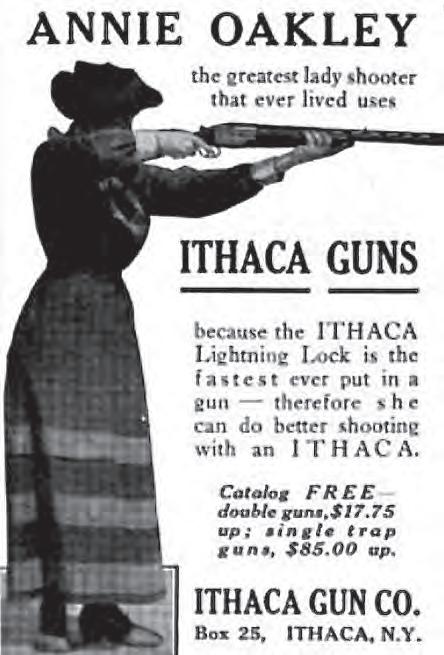 By Charley Githler
By Charley Githler
For many years, if anyone outside the region had heard of Ithaca, it was very likely because of either Cornell University or the guns of the Ithaca Gun Company. Now, except for its reputation among gun owners and collectors, Ithaca Gun has mostly receded into local history. Only the smokestack remains as a physical reminder of the factory, and issues surrounding redeveloping the site have swirled for years, but the story of the company’s rise and decline are an important part of Ithaca’s heritage.
e genesis of the Ithaca Gun Company dates back to Ithaca’s manufacturing heyday. It was a feature of America’s growing Industrial Revolution during and a er the Civil War that businesses were seemingly freely started and abandoned. ere was a “can-do” spirit in the air, and if an enterprise failed, you picked up and tried something else. Ithaca Gun was born in that context.
Lewis Smith, of Center Lisle (near Whitney Point on today’s Route 79), had failed in the tanning business, so he started a general store. en, at some point he connected with William Baker, also a Center Lisle native, who had designed and patented several improvements to gun mechanics, and by 1863, the two of them
joined forces and began manufacturing rearms, rst in Marathon, then in Lisle.
Soon Lewis’ sons, Leroy and Lyman, worked in the business and it grew. By 1877, they had moved to Syracuse, making “Baker’s Patented Double Breechloaded Gun.” en in 1883, Baker and Leroy Smith relocated to Ithaca as the “Ithaca Gun Works” where they purchased, for $6000, the property, ume, water wheel, and water rights on “water power lot #6” on Fall Creek. By 1885, they were calling themselves the Ithaca Gun Company.
e site they bought was already in an industrial pocket. It had most recently been the Ithaca Falls Steam Bending Hub and Spoke Works furnishing, according to an 1881 Ithaca Journal advertisement, “bentwork, hubs, spokes, etc. for carriages and sleighs.” at section of Fall Creek, thanks to Ezra Cornell’s 1832 dam and tunnel, supplied a reliable source of water power and there were grist mills, saw mills, and the Ithaca Paper Company that dated back decades by the time Smith and Baker got there.
In 1886, Leroy Smith and his brotherin-law George Livermore bought out the Baker interests, and the company became a family business, which it would remain
for the next 81 years. Leroy himself was involved in the design of some of the company’s guns, and patented four “hammerless” shotguns in the late 1880s.
In time, Leroy Smith and George Livermore agreed in a handshake deal to split the company equally. Ithaca Gun incorporated in 1904, and the Smith and Livermore branches of the family each got 50% of the stock. Leroy and George and their descendants would alternate in executive positions until the mid-1960s.
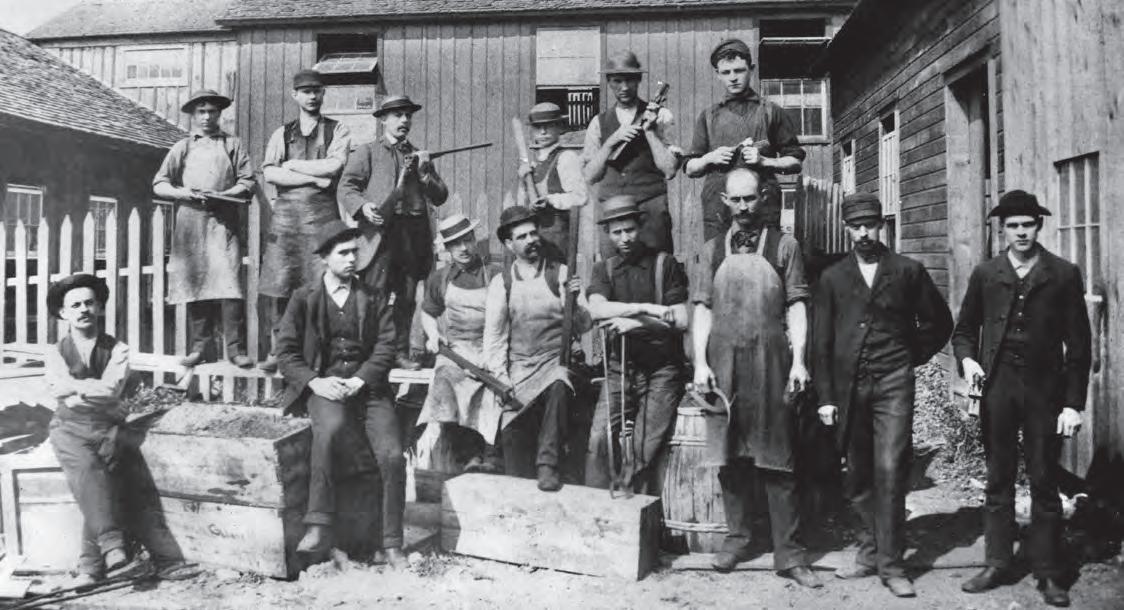
e rm grew quickly. By 1900, Ithaca Gun had 80 employees. A series of expansions of the physical plant (1890, 1904, 1917) brought the facility from the bank of Fall Creek to the edge of Lake Street, and the company’s rise to prominence t squarely within the rise in general manufacturing in the late 19th century in Ithaca. In the 1880s, when Ithaca Gun became an Ithaca company, the newly-minted city (incorporated in 1888) had a glass company, cigar factories, the Ithaca Calendar Clock Company, a hive of industrial activity around the inlet/ canal and a host of other small companies. In 1890, there were 80 rms in and around town, selling $1.7 million in products.
In fact, even with all the new businesses, industrialization was still kind of new in the 1880s. Before 1811 in New
York, a manufacturing company could be incorporated only by a special act of the New York State Legislature; a cumbersome process. Even a er that, there were limitations on a company’s size and the types of manufacturing that were permitted. But by late in the century, a company could commence business much more freely, and could incorporate by ling a certi cate with the Secretary of State. Of course, the labor movement grew in step with this surge in new businesses. In April 1881, Ithaca cigarmakers went on strike to oppose an anticipated wage cut. In January 1881, 21 women at the Button Works on the corner of Auburn and Franklin Streets walked out, demanding higher wages. ( e factory relocated to Scranton, Pennsylvania in response.)
Ithaca was by no means unique in this regard. ere was scarcely a city of any size in the Midwest or Northeast that didn’t have numerous manufacturing businesses at the time. Not all the companies would survive, but Ithaca Gun did, and its longevity as a family business makes it as noteworthy as its success.
Also, there were the guns. Very early, the company developed a reputation for high quality, innovative design and artistic decoration. Ithaca guns were particularly noted for exquisite engraving on metal components as well as elaborately-carved wooden stocks. One of its greatest successes was in 1907, when Ithaca Gun bought the rights to Emil Flues’ patented shotgun that had only three moving parts per barrel. ey upgraded the design and the Ithaca Flues double-barrel shotgun became the best-selling American-made gun of its kind, with more than 223,000 sold by 1926. It e ectively drove Remington out of the double barrel shotgun market.
All businesses ebb and ow, of course, but the rst three decades of the 20th century were ush times for Ithaca Gun. During the 1920s, the company was making 50,000 guns per year, and its products were being sold and advertised widely. Annie Oakley insisted on Ithaca guns when she performed in Bu alo Bill’s Wild West Show. John Philip Sousa (at one time president of the American Trap Shooters Association) was an Ithaca Gun enthusiast. Dwight Eisenhower and George C. Marshall owned Ithaca double-barrel shotguns.
en the Great Depression hit and sales took a nosedive. At the lowest point, in the years 1931-1933, the sales force was reduced to 18-20 workers at any given time. Around 1937, though, the company began production of what is probably its best-known and most popular shotgun, the Ithaca Model 37. It was an almost immediate success and went on to have the longest production run of any pump-action shotgun, and more than two million of the guns have been sold over the years since. Lightweight and durable, its bottom-ejecting feature made it adaptable for either right- or le -handed users. It became the standard issue shotgun for the Los Angeles and the New York City police departments and is still available today.
In December 1941, the United States entered World War II, and the entire plant capacity was devoted to the war e ort. All the civilian gun manufacturing equipment was packed into storage. Before the end of 1942, Ithaca Gun employed 900 men and women in day and night shi s, working around the clock. e company made, among other things, Colt .45 Automatic Pistols, producing 382,000 of them by the end of the war.
A er the war, the company was sustained by sales of the Model 37, and various products for the U.S. government
and law enforcement agencies. Successive generations of the Smith family continued to run the rm. George Livermore actually remained as Chairman of the Board of Directors until his death in 1950 at the age of 104. (His son Paul le the family house at 313 North Aurora Street to the Ithaca community. It currently houses the Ithaca United Way.)

By the 1960s, though, things changed. For one thing, there was a shi in the culture. e civilian demand for shotguns leveled o . America was no longer a rural country where “every farmer needs a shotgun.” Furthermore, nobody in that generation of the extended Smith family was interested in running the company. It
was decided that Ithaca Gun should be put up for sale.
e company was a family business in more than one sense though, in that there were families that had generations of gunmakers that had worked for Ithaca Gun. In deference to those employees, the Smith family held out longer than they should have, turning down a number of o ers that didn’t promise to keep the company in Ithaca. Ultimately, a holding company bought the factory and the gun designs, becoming a diversi ed entity called General Recreation, Inc. e Smiths got the promise to stay, but not in writing.
Exploring Ithaca’s spectacular landscape with her trusty pal, Tasha, gives Loretta great scenery and even better company. Whether she’s hiking to the heart of the gorge or just taking in the falls, she always enjoys the natural beauty of the area.

Living on the 105-acre campus of Kendal at Ithaca not only keeps Loretta connected to the places and companions she loves, but the care she may need someday. And, from here, the story just keeps getting better.
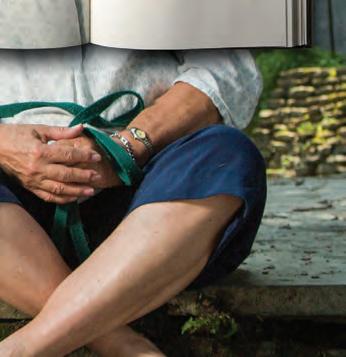
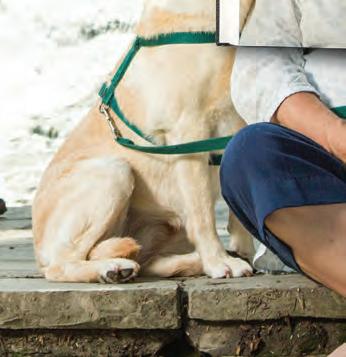


800-253-6325 kai.kendal.org
Come for a visit and tell us your story. Call 877-891-7709 or go to kai.kendal.org/IT2 to learn more.

N. Triphammer Rd., Ithaca, NY 14850



In 1994 Marti and Tom Macinski, owners of Standing Stone Vineyards, planted an acre of Saperavi grapes. Two other winemakers in the Finger Lakes—McGregor Vineyard and Dr. Frank Vinifera Wine Cellars—also had this ancient variety from the Republic of Georgia in the ground. Until 2011, no one was allowed to put the name “Saperavi” on a bottle because the Alcohol and Tobacco Tax and Trade Bureau (TTB) did not recognize it as a wine-making grape. is is ironic because archaeological evidence shows that the Georgians have been making wine in the Caucasus Mountains for 8,000 years.
On May 12, 2022, Dr. Frank Vinifera Wine Cellars held its rst Saperavi festival. It was, said owner Fred Frank, a tremendous success. About 300 people tasted both Saperavi and Rkatsiteli, the most popular red and white wines, respectively, from Georgia. In addition to the host vineyard’s wine, visitors were able to taste several wines imported from the small republic east of the Black Sea and north of Armenia.
Konstantin Frank, who was a professor at the polytechnic university in Odessa, Ukraine, brought Saperavi and 59 other grape varieties over to the Finger Lakes in

the 1950s. Like other Old-World wineproducing varieties, it is derived from Vitis vinifera. While Konstantin was an academic, his son Willy was a businessman.
“When he took over in 1984,” said Willy’s son Fred, “he began to run it as more of a business and less as an experiment.” Willy Frank whittled down the list of wines made to more proven varieties. Saperavi took a back seat.
It is a teinturier variety, which means that both the skin and the pulp are red. “We don’t need to soak it on the skins as long,” Frank said. “Most wines get more tannic while the color leaches from the skins during maceration.” Maceration is the part of the winemaking process during which tannins, color, and avor leach into the must, the mixture of pulp and juice in the tank. In most grape varieties the juice is grayish or clear, but with teinturier grapes it is red from the start.
Saperavi’s shorter maceration is an advantage in the East, Frank said, where grapes may not ripen fully before harvest. Saperavi is not especially winter-hardy, less so than Cabernet Franc or Lemberger (Blaufränkisch) but more so than Pinot Noir. e bunches are very loose and it is, according to Frank, less prone to rot (until it isn’t, as we shall see).
Frank praised the deep red color of Saperavi and described the avor prole as “all across the board,” changing greatly with growing conditions. Dr. Frank Vinifera Wine Cellars grows this grape near Keuka Lake in a site that is steep and stony with shaley, acidic soils. In 2007 they planted Saperavi in the Hector “banana belt.”
“ e water in Seneca Lake is 600 feet deep, which moderates the winter temperatures,” Frank said. “ e vineyard there has deep, loamy soils that are more basic, less steep, and less rocky.” e Dr. Frank Saperavi wine is a blend of grapes from these two locations.
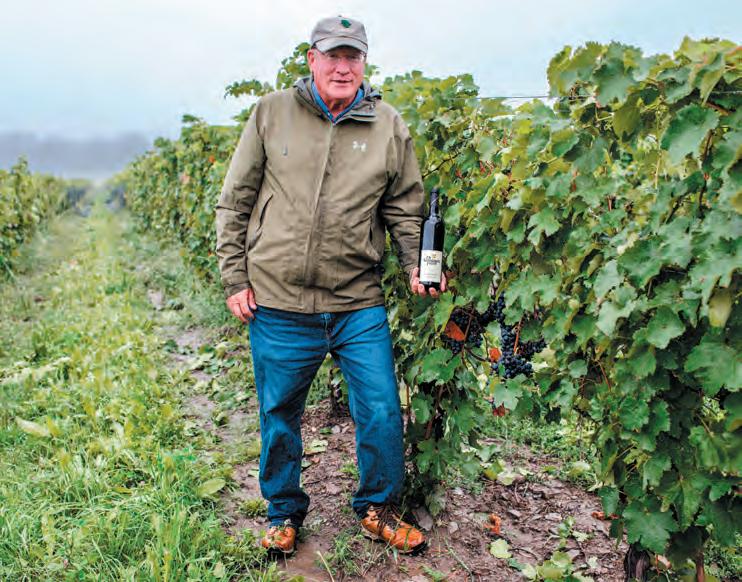
“It is fermented in steel with an open top,” he said, “and manually punched down.” is latter process breaks the skins. “ en we move it into French oak barrels for a second malo-lactic fermentation.”
e conversion from malic to lactic acid creates wine with a rounder, fuller mouthfeel. A er the second fermentation it is kept in new French oak barrels for about a year before bottling.
Dr. Frank produces between 500 and 750 cases of Saperavi per year, and every year they are planting more vines of this variety. In the early 1960s, during
Konstantin’s time, production was more limited and sporadic. Fred Frank worked with his grandfather during high school and college. Although he studied business at Cornell, he worked in the wine industry for many years a erward. A er he succeeded his father as president of the winery in 1993, he began to blend the philosophies of the previous two generations, an approach continued by his daughter Megan, who has graduate degrees in both business and the science of wine. Saperavi is again on the shelves.
The popularity of this Georgian grape took off about nine years ago, according to Fred Frank. “You need multiple makers to popularize a wine,” he said. “Saperavi is one of the up and comers. The next big buzz is going to be sparkling wine.”
Which is interesting because that is one of the things that Fred Merwarth makes with it. Oskar Bynke, Merwarth, and his wife Maressa own Hermann J. Wiemer Vineyard in Dundee, which in 2017 acquired Standing Stone Vineyards in Hector, along with what had expanded to 8.5 acres of Saperavi grapes.
Merwarth had no prior experience with Saperavi and, he said, Standing Stone really didn’t either. By 2017 the Macinskis had only made a couple of barrels of wine because only an acre was producing grapes. However, they planted over seven acres a er 2014, and by 2021 all of these vines were producing.
It is in a single block that extends from the Seneca Lake shore eastward up the hill. Merwarth, who is also the vineyard manager, noted there are interesting undulations in the block. e rows run north-south, divided by an east-west road. North of the road the vines are bigger with higher production. ese are berries he uses for sparkling wine and rosé.

South of the road the vines are smaller, produce less and are used to make red wine. “We tackled it in a systematic way,” Merwarth said of making Saperavi wines. ey begin by selecting grapes from several di erent places in the block in order to eventually blend them. All their grapes are hand-picked.
He, winemaker Dillon Buckley, and assistant winemaker Bryanna Cramer focused on rosé first. “We picked early and it had screaming acid,” Merwarth said. They put whole clusters in the tank and pumped over the juice instead of punching down. They made it in steel, wood, and stone tanks and blended the results. “The stone was interesting,” Merwarth said. “It rounded out the fruits.” They add Gewurztraminer—up 5-6%—in
order to lighten the rosé and round out the taste.
Merwarth said the acidity of Saperavi is perfect for sparkling wine. “We stop the cuvée [juice extraction] at 30%, so Saperavi doesn’t yield a lot,” he said. “We usually go to 70% with other grapes.”
While they produced and sold rosé and sparkling Saperavi, they continued to search for the best way to produce a red varietal bottle. “We were surprised by the lack of tannins,” Merwarth said. “So, we started adding whole clusters and doing pour overs.” ey focused on getting enough heat from the fermentations. “We found that it lacked a mid-palate structure; the avor is up front and then drops o .”
e acid level was high—12-13 grams per liter—even when the grapes were very ripe when picked.

“We have a philosophy of not adjusting the wine,” Merwarth said, “so we had to adjust the process of making it.” For example, by varying factors in malo-lactic fermentation they could reduce acidity.
He gave a lot of credit to his winemakers, Dillon and Bryanna, who are both intrigued by this exotic grape and have pushed ahead with the experimentation in the winemaking process. eir plan for the coming harvest is to try carbonic maceration, a process used to make Beaujolais. is method uses a closed-tank to create a carbon dioxide-rich environment. Fermentation takes place inside the grape while it is still whole and uncrushed.
Saperavi is quite versatile. In addition to being suitable for rosé, sparkling wine, and varietal bottles, it can also be





What is Gourdlandia? It’s a place that honors the gourd, according to owner and gourd artist Graham Ottoson .

“It’s a little bit hard to categorize Gourdlandia, because it’s kinda like a farm, kinda like a gallery, a little bit like a shop,” Ottoson explained.
e farm/gallery/shop is located at 77 Rachel Carson Way in Ithaca’s EcoVillage, a co-housing community with more than 200 residents. Gourdlandia is open yearround to visitors of all ages and artistic abilities, though some of the projects have minimum age recommendations. e best time to tour the gourd garden is late summer to early fall.
Visitors can browse the shop, explore the gourd garden, watch a demonstration, learn about the gourd art process or make a piece of gourd art to take home.
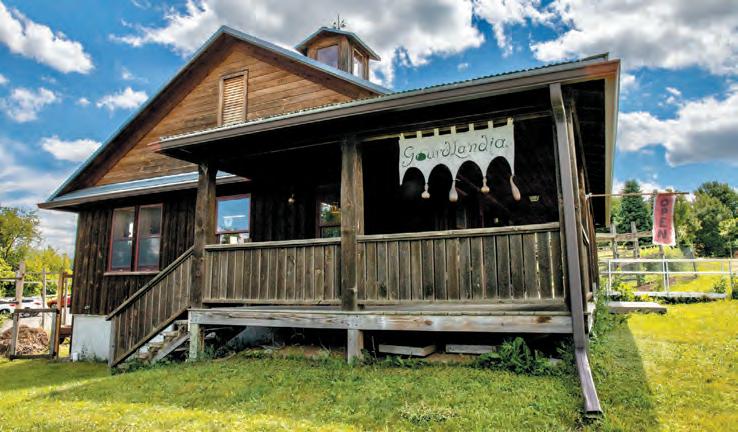

“ e gourds are so accessible. You just need a few simple tools,” Ottoson said. “It’s hard to mess up a gourd.”
A er 25 years spent “catching babies” as a midwife her childhood creative urge was reborn and she started looking for a new cra .
Ottoson’s fascination with gourds sprouted on a serendipitous drive to Candor, New York. On the way there, something caught her eye. On the way back, she stopped to investigate.

“It was just six gourds at the end of this guy’s driveway. at’s all it was. And we went up and we met the guy, and we learned all about growing gourds,” Ottoson said.
Their interest piqued, Ottoson and her husband Otto started growing gourds. Eventually, they had a surplus pile of gourds and no idea what to do with them.
“And the way Otto tells it, he says, ‘I came home and she was making a [gourd] lamp,’ Ottoson said.
At rst, Ottoson worked out of her home, operating her business under the name Hands on Gourds. A er moving into the studio space built by her husband, Gourdlandia opened in 2014, and the rest is history.
“I’m having a lot of fun here at Gourdlandia. I didn’t even know I could be a businessperson; you know what I mean? And I worried about some of the aspects, like marketing and bookkeeping and any of the bureaucracy,” Ottoson said. “I didn’t know for sure that I could make a living as an artist, and now that I know that I can, I’m really relaxed and I don’t feel like I have to.”
O entimes, Ottoson explained, visitors come to Gourdlandia and they don’t know

what a gourd is—it’s a member of the squash family—much less the history and culture of gourds.
She blames this on the historic connection between humans and gourds being largely lost in the modern-day era.

“People and gourds go back about as far as people and dogs, and really have had about as much meaning for each other. Gourds were the rst musical instruments in a lot of cultures. ey predate pottery. And they’ve been used all over the world for so many di erent purposes. It’s just a long and rich history,” Ottoson said.
Gourdlandia operates under a “design your own class” method, which Ottoson said has been quite successful and can be tailored to each person’s interests.
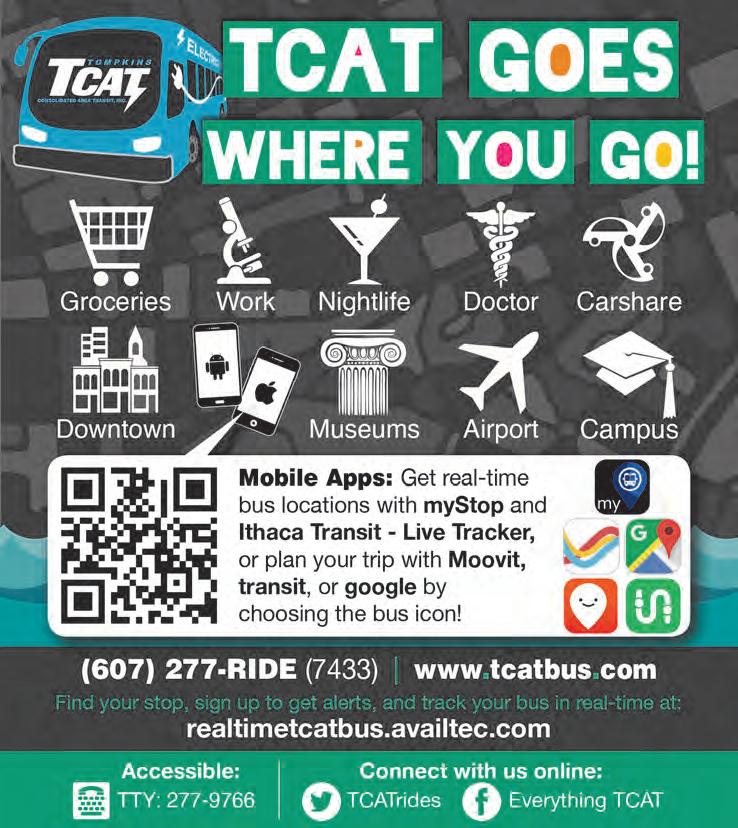





“People choose from a list of projects on my website, and then just set it up. It can be just one person…or it can be a group of six people for a birthday party or something,” said Ottoson.



One of the simpler gourd projects is making a nightlight, which takes about an hour and can be done by children as young as eight. For this particular class, people don’t need an appointment, but can instead drop in any time Gourdlandia is open. According to Ottoson, it’s the perfect rainyday project, or unique activity for tourists.
For lengthier projects—such as a hanging pendant lamp, a bowl, a keepsake box or a basket—Ottoson explained that people should schedule a class ahead of time and that they generally aren’t a suitable activity for young children given their three-to- vehour length and the use of sharp or hot tools.
Gourdlandia is open Mondays, Tuesdays, Fridays and Saturdays, or by appointment. e speci c hours are posted on their website: https://www.gourdlandia.com/.

Re ecting on what visitors enjoy most about Gourdlandia, Ottoson said they seem to appreciate the endless opportunities for creativity and the versatility of the gourds.


“For some people, [they enjoy] making stu . I think for other people, it’s just seeing what you can do with this unique vegetable that you can grow in your yard.”

 By Elijah de Castro
By Elijah de Castro

For those in wishing to hop on a bike for leisure, sport or commute, Ithaca has a number of bike shops, trails, and events that make it easy. Additionally, with local activists pushing for a Bike Share program and more bike lanes, the city is on a path to being an up-and-coming haven for cyclists.


Currently, there are ve major bike paths in the Ithaca area; the Black Diamond trail, the Gateway Trail, the Dryden Rail trail, the South Hill Recreational Trail, and the Waterfront trail.




e Black Diamond trail is an 8.5-mile stone-dust path that connects Taughannock Falls State Park and Cass Park. A two-way multi-use trail that runs parallel to route 89, the trail is used for both leisure, exercise, sport, and commuter biking.
Michael Smith is a professor of History at Ithaca College who has biked from his house on Farm street to Ithaca College every day since he began at the college 21 years ago. Smith says that in addition to biking the streets of Ithaca, he also uses the Black Diamond Trail to enjoy biking without the automobile tra c he navigates on his regular commute.
“I use the Black Diamond [Trail] especially if I just want to have a day of riding when I don’t have to even think about cars,” Smith said. “Round trip from my house is about a 20-mile ride if I want to pop down to the Taughannock State Park.”

e Gateway Trail is two miles, stretching from the parking lot of Home Depot on Ithaca’s South Side to South Aurora Street on South Hill.
e Dryden Rail trail is a partially completed 14-mile trail that runs through Dryden, Freeville, Varna and the eastern end of Cornell’s campus. Currently, 4.3 miles of the trail is uncompleted, however, the path is slated to be completed by July 2023.




In addition to biking on the Black Diamond trail, Smith uses the Dryden Rail trail and the Waterfront trail for running. Smith said the uncompleted parts of the
trail Black Diamond trail do not allow him to bike there yet.
e South Hill Recreational Trail is a 2-mile trail that takes bikers from Burns Road in the outskirts of Ithaca to the South Hill end of Hudson Street, near Ithaca College.
Ducson Nguyen, the alderperson for Ithaca’s second ward, said one of the best parts of biking in Ithaca is the trails that surround the city, and the ability they create to access nature while getting exercise.
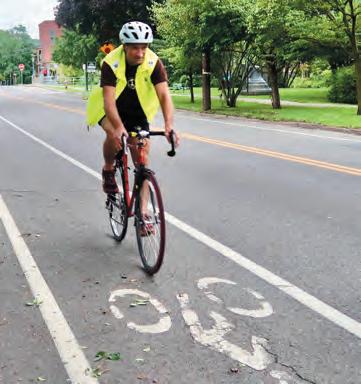
“I do love our trails,” Nguyen said. “I take the Black Diamond Trail, South Hill recreation trail, and the Dryden Rail Trail.
ose are really good ways to connect to Ithaca. We’re lucky to be blessed with these great trails.”

From 2018–2020, Ithaca had its own bike share system run by Lime, a Silicon Valley based transportation company specializing in electric bikes and scooters. Eventually the company left Ithaca in 2020, taking its fleet of bright green bikes with it. However, recent efforts by local activists and the organization Bike Walk Tompkins are aiming to create a community owned non-profit bike share to Ithaca.

Je Goodmark has been the Director of Micromobility at the Center for Community Transportation (CCT) since July. As the previous operations manager for Lime in Ithaca, Goodmark says that a community-based model for bike share will be a better way to increase biking accessibility for Ithacans.
“CCT is currently in the process of trying to bring bike share back to the city,” Goodmark said. “ is time we’re approaching it from a community owned, not-for-pro t standpoint. Our goal is to have a eet of electric bikes that people can use exactly like they used Lime to be available throughout the city and beyond.”

ere are also a handful of bike shops in Ithaca. Open since 1994, Cayuga Ski & Cyclery o ers new bicycles and a variety of bicycle repairs.
Je Inman is the owner of Cayuga Ski & Cyclery. Inman said the store saw a huge increase in sales that was so large he could not keep up with demand.


“During the second half of 2020 and into 2021 we had unprecedented growth in an extremely short amount of time,” Inman said. “It all started when the high school was sent home and kids getting bikes because they’re home now, and then parents getting bikes to ride with kids.”
While Cayuga Ski & Cyclery specializes in repairs on man-powered bikes, Green Street’s Boxy Bikes rents and sells electric bikes, which are growingly popular in the area.
Like Inman, Sequoia Valoy—the owner of Boxy Bikes—has struggled to keep pace with demand. Valoy said via email that many locals who are interested in purchasing electric bikes have been using his rental eet.
“I have used my own fat-tire electric bike as my main transportation for years,” Valoy said. “As such, I have ridden it anywhere I have needed transportation, from up to 4-H Acres as a counselor at Primitive Pursuits, to Wegmans to pick up groceries, to Brookdondale to visit the water hole there. For recreational riding, however, nothing beats Black Diamond trail. Many of our rental customers choose to take this path.”


In addition to bike paths, Ithaca also has a urry of di erent bike-related events for both recreational and sports purposes.


is includes the AIDS Ride for life, an annual bike race that raises money for the Southern Tier AIDS program.

Additionally, on Sunday September 18, Bike Walk Tompkins will host the 10th anniversary of StreetsAlive!, a festival in which an 11-block stretch of North Cayuga Street (between Court Street and the Ithaca High School) and part of West Court Street is closed for tra c. en, Ithacans and their families ll the streets to bike, scooter, walk, and play.
Nikki Friske, a Bike Walk Tompkins sta member and the director of this year’s festival, said in a press release that in the following years, the organization hopes to expand the frequency of StreetsAlive!.
“ e response from local people and organizations signing up to be activity hosts along the festival route has been tremendous, and shows the huge potential for joy, social connection, and capital “L” love when we close the street to cars,” Friske said in a press release.
Nguyen said that as an alderperson, he supports biking not just for pleasure and exercise, but also as a form of zero-carbon transportation.
“When I joined [Common] Council actually, I walked to work,” Nguyen said. “I was also going to TCAT headquarters and City Hall and everywhere else, so it became impractical. Commuting is actually how I got started biking as an adult.”
Dr. Mary B. Boardman Doctor of Ministry M.A. In Marriage and Family Therapy









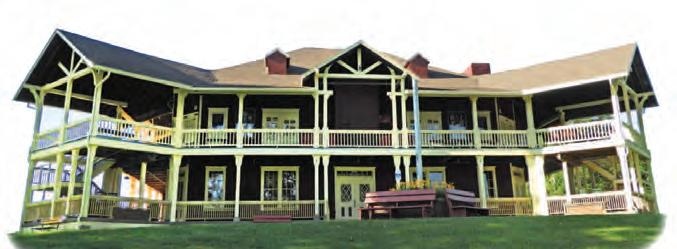
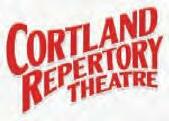





































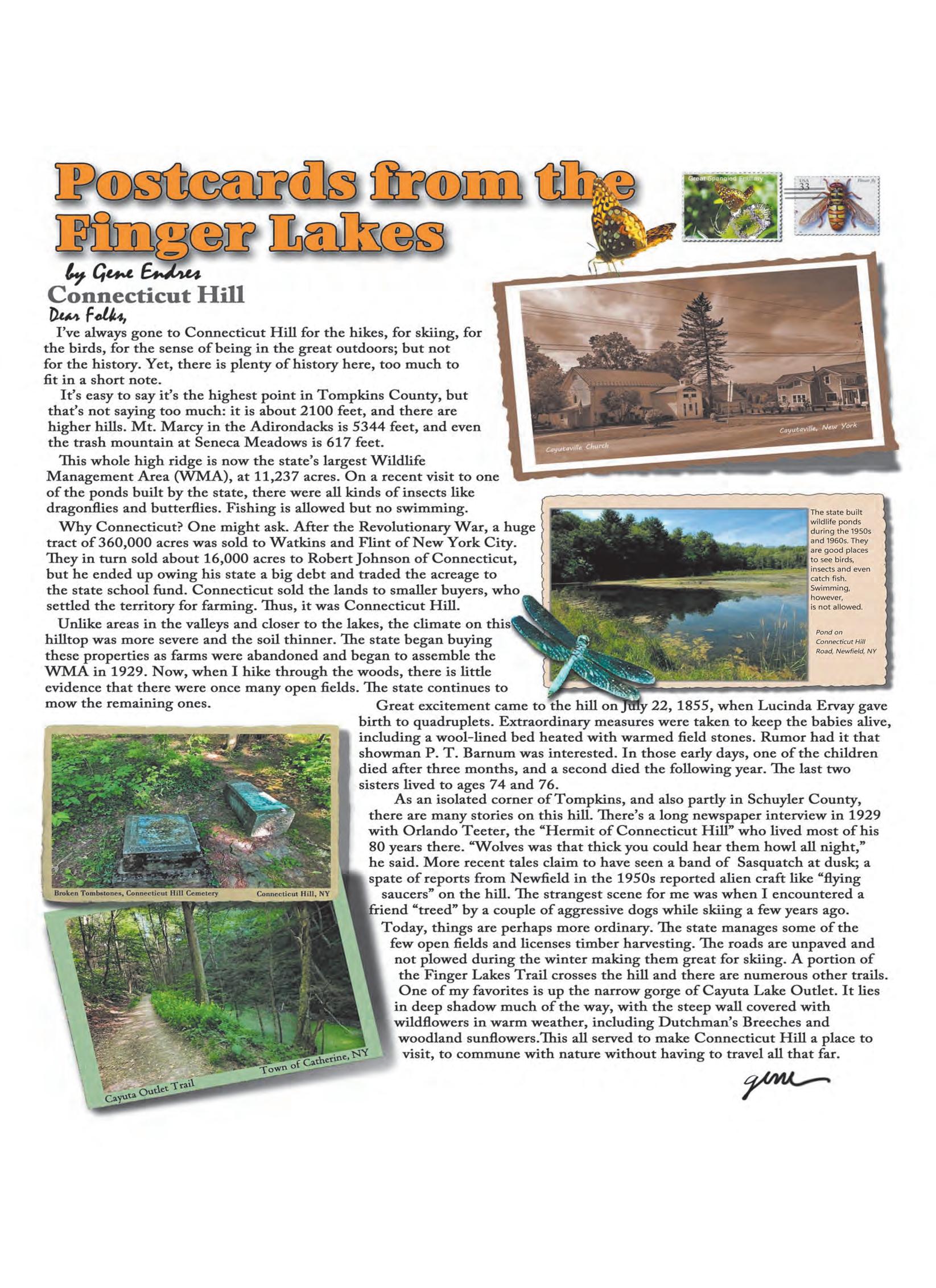
It didn’t go well. While gun manufacturing continued, General Recreation led for Chapter 11 (Reorganization) bankruptcy in 1978, and the plant closed. It was recongured and reopened by local investors in 1979, but the company led again for bankruptcy in 1986, furloughing 100 workers. In the end, manufacturing was moved out of Ithaca to King Ferry in 1989. e company endured a number of sales and relocations in the ensuing years, and currently operates out of Upper Sandusky, Ohio.
e fate of the site of the former factory is a topic more familiar to recent generations of Ithaca residents. e company had operated on the property between Fall Creek and Lake Street for over 100 years.


e building itself was described as a “hodgepodge of old and new, not suitable to repurposing to other industry” at the time of General Recreation’s rst bankruptcy. More ominously, a century of gun testing and manufacturing residue had le a toxic legacy. It was also the location of uranium metal tube testing in the early 1960s for the federal nuclear weapons program.
A er the second bankruptcy in 1986, the buildings were shuttered. A 1997 environ-




mental site assessment commissioned by the City of Ithaca found that the main factory was extensively contaminated with lead and other toxins. e whole location ultimately became an EPA Superfund site. ere have been numerous private and public remediation projects, with the goal of rendering the property suitable for development, and there have also been numerous development proposals since then, which have been abandoned in the chaos and expense of addressing the cleanup of the property.
It has been a cascade of unpleasant discoveries. Between 2002 and 2004, the EPA spent $4.8 million to reduce lead levels, and they removed 4,500 tons of lead-contaminated soil between the factory building and the creek. Still, tests in 2006 showed the continued presence of lead, as well as arsenic, cadmium, and chromium. Furthermore, the building had become a gra ticovered hazard, with scores of mattresses and at least one re. At a cost of $2 million for demolition and remediation, the old Ithaca Gun factory was torn down in 2009. ere were unexpectedly-high levels of asbestos and barium present, so most of the bricks and mortar had to be removed from the site. Again in 2015, the EPA removed another 200 cubic yards of loose stone and lead-contaminated soil from lands bordering the site of the factory.

As recently as 2017, DEC soil samples revealed that lead levels on the nearby Ithaca Falls Gorge Trail exceeded the EPA’s removal management level, but also declared “that the site no longer poses a threat to human health or the environment”.
ere does seem to be progress on the prospect of redevelopment, though. A 2020 amendment to New York State’s Brown eld Cleanup Program seems nally to have cleared the way to moving forward, and last December the property was acquired by 121-125 Lake Street, LLC, owned by Visum Development Group.
Currently, Visum is proposing to build a four-story, 77-unit, 109-bed market-rate apartment building—a mix of studios and one- and two-bedroom apartments— called “ e Breeze Apartments.” e project is wending its way through the process of getting Planning Board approval and is a frequent item on the Board’s meeting agendas as issues regarding nal soil clean-
up and the nature of site improvements are addressed. e fate of the last remaining physical feature of the old factory—the Ithaca Gun smokestack—is up in the air.
In its day, the Ithaca Gun Company was a major local employer and a pillar of the thriving industrial portion of Ithaca’s economy. e company’s reputation for high-quality, artistically-decorated guns was international in scope and lives on among collectors and hunters. As with much of our industrial past, Ithaca Gun’s legacy is also inextricably entwined with the environmental costs of manufacturing. Still, the Ithaca Gun Company is an essential part of the story of the City of Ithaca.

blended. While the Macinskis original plan to combine with Pinot Noir was unsuccessful, Merwarth has liked blends with Petit Verdot and Cabernet Sauvignon.

While the winemakers adjusted the production process, Merwarth also followed a learning curve in the vineyard. “When it’s done, it is really done,” he said of Saperavi ripening behavior. “You have to pick it right away.” e clusters, he said, are big and heavy and when Botrytis fungus (“noble rot”) appeared, it did so in a unique way. Instead of developing spots where adjacent berries touch, in this loose-clustered variety the whole berry gets infected.
Saperavi grapes are generally ripe by the middle of October. At Labor Day they were a dark color but were not “ lled out.”
As they ripen, Merwarth said, the berries actually droop on the cluster, which is unusual.
He has planted Saperavi on the west side of Seneca Lake at the Wiemer vineyard. He noticed two forms in the Standing Stones grapes; the older plants



A diverse, welcoming, justice-centered spiritual community Corner of Buffalo St and Aurora St Worship services Sundays mornings 10:30 am


you are welcome.


have round berries, but the younger ones produce oval ones. He planted both in Dundee.
Fred Frank noted that the avor of Saperavi varied greatly, depending on the conditions where it was grown. Fred Merwarth contacted Saperavi expert and wine importer Lisa Granik, who brought him several bottles, all from Georgia. She and Merwarth sat down and tasted them. “Normally,” he said with wonder in his voice, “a er you taste several bottles of say, Cab Franc, you can say, ‘Ok, that’s from the Loire, that’s from Bordeaux, that’s from Friuli,’ but not Saperavi. Lisa brought 40 bottles and they were all di erent.”
Faith Community stjohnsithaca.org Rev. Megan Castellan, Rector Sunday Services 8 am, 10:30 am In person and online Wednesday Evening Prayer 6:00 pm




John Flansburgh, co-founder of ey Might Be Giants sat down with me recently to discuss playing an anniversary tour two years late, car accidents, and Ithaca record stores.

Ithaca Times: Of all the live shows that got COVID-cancelled, you and John Finnell had been planning a 30th anniversary tour built around your 1990 album “Flood,” and now it’s 2022. Are we still talking about “Flood” or “Apollo 18” (1992)?
John Flansburgh: We’ll be performing all of “Flood.” But “Flood” is only forty minutes long, and our show is two hours long, so there’s plenty of other stu . For us, that’s the saving grace, ‘cause we’re not locked into something monolithic.
IT: I’ve been having these visions of endless cartons of “Flood” commemorative merch being buried in a warehouse, like the Ark of the Covenant from “Raiders of the Lost Ark” (1981).
JF: [laughs] at’s a pretty good description. You know, the last two, three years have been really long for everybody, including us. So far this year, we’ve been able to do exactly one show, and then I was on my way home from the rst show in an Uber, the car I was in got hit by a drunk driver in Manhattan, and it took me two months to recover.
IT: Oh my God.
JF: Yeah, I broke—the doctor at the trauma center said I had broken most of my ribs. I was explaining to him how I had to get to Washington, D.C. in the morning, still very much high on the adrenaline of the accident, and not feeling that bad yet. And I was like, “I’ve got to get to D.C. in the morning, I can’t hang out.” And he was like, “Well, you’ve broken most of your ribs [laughs] as far as I can tell, some of them in a couple of places, so I suspect you’re not going anywhere for [laughs] quite some time.”
IT: Oh my God.
JF: Yeah, it, uh…it sucked. I don’t recommend getting hit by a car to anybody.
IT: I don’t think anybody’s ever recommended that.
JF: [laughs] No, I know, but try to drive as defensively as you can. So it’s been a long summer for me. I spent over a week in the hospital, and I’ve just been in bed for the last two months. I’m puttering around now, and I’m in pretty good shape. I’m doing physical therapy, and I’m de nitely on the mend.
IT: So you haven’t started the tour yet.
JF: Well, we did one show [laughs], we had a week and a half of shows; we’d taken two months of touring and kind of divvied it up over about twelve months. Even if a portion of the tour gets knocked out due to COVID, we won’t be cancelling a whole month or two months of shows, which seems kind of ill advised. So we’re just doing things in kind of ts and starts now, and the o cial rst “ t” was going to be in Manhattan and Philly in June, and that’s when I got hit by a car.
IT: Uh! Another delay.
JF: It’s insane. I mean, at a certain point, you just…It’s so funny, like, I think of the number of postponements in our career, I probably could have counted on one hand. And now with these shows like the one in Ithaca, which has been sold out for two years…I think we’ve re-scheduled it three times now.
IT: I wonder if some people who bought tickets are students who’ve graduated and moved away.
JF: I’m sure there’s a healthy secondary market on these tickets. I mean, yeah, people graduated, people moved to other towns. Life goes on. You know, COVID has just scrambled everything.
IT: It feels like “Flood” was the album that broke you into a wider pop awareness. Is that accurate?
JF: Absolutely. Our rst four albums were all just like a steady climb, you know? Just because there were just a lot more cultural gate-keepers back then. I mean, our rst album got a lot of attention on MTV and woke up a speci c kind of audience: the record store clerk “High Fidelity” audience came aware very quickly through that exposure.
IT: Hey, I was a record store clerk. [laughs]
JF: I was a record store clerk.
IT: Oh, man.
JF: What years? I worked in a really crummy record store.
IT: I worked in a place called Discount Records which was owned by Sam Goody and then we changed our name to Sam Goody.
JF: I know Discount Records! Like, in Ithaca, or…?
IT: In Ithaca.
JF: Were you working there in 1976?
IT: No, I would have been in eighth grade at that time. I was there near the ever-lovin’ end from ’98 to 2000.
JF: Oh, so, late in the day! Yeah, yeah. I bought “Hey Joe”/”Piss Factory” by Patti Smith and “Little Johnny Jewel” by Television, on 7” singles, I think on the same day, at Discount Records in Ithaca.
IT: What comes to mind when I say “Minimum Wage” [from “Flood”]?
JF: Well, I had, from the age of 17 to 22, I worked a lot of minimum wage jobs. I worked as a bus boy. I worked in a parking lot. I worked as a clerk. So you kinda get the full experience as you kind of cast around di erent experiences like that. Most of it was really dull, but I actually learned—in the parking lot, I kind of taught myself to play the guitar, so I can’t complain too much, but I do like to complain.
IT: Gotta ask about “Istanbul (Not Constantinople)”.
JF: at was a song that my mom and my aunt actually introduced me to, when they were going through a songbook of old songs from the 40’s and 50’s. I think it was just piano music in a music bench. And that was my introduction to the song. It’s become very clear to me that it’s a soundalike of “Puttin’ On e Ritz”, or a knock-o of it. ere are a lot of songs in the world like that.
ey Might Be Giants are playing the State eatre on Wednesday, September 21. Doors open at 7 p.m. and the show will begin at 8 p.m. e show is for ages 16+ only and IDs will be checked at the doors.











When I was a student at Cornell
I used to bring my visiting parents to dine at Taughannock Farms Inn and we always enjoyed our dinners. I still enjoy my dinners at the restaurant that has the same footprint but has acquired a new name under recent owners: e Inn at Taughannock Falls. It’s a large building that was built in 1873 as a summer home for an obviously wealthy couple. In 1925, the owners sold 800 of their acres, which included Taughannock Falls, and what is now the adjacent state park to New York State for $10,000.
views from The Inn are as outstanding as the food. (Photo: Provided)

ere are three sides available with the six entrées, a creamed broccoli rabe and two potato preparations; each is $9. Frankly, a er spending almost $50 for entrées that featured various accompaniments and sauces on the plate, I wasn’t inclined to bring the main course price up to near $60.
I’m happy to say the atmosphere is still elegant with a theme of white linen tablecloths, navy blue napkins, and an interior that follows the dark blue and white theme. Each table has a small ickering candle and a small vase with herbs.
I’m also happy to say the service is still attentive and e cient.
















And most importantly, the food is outstanding.
I must also tell you that it’s expensive to eat here. ere are only six entrées and they range in price from $32-48. Among the six, there are two beef steaks, one rack of lamb, a snapper ( sh), Chicken Milanese and a pasta dish ere are o en a couple of daily specials that t within the same price range. During my last visit they were $36 and $42. ere are also six appetizers priced from $13 to $25. ere is a complimentary o ering of homemade bread and compound butter.
I recently ordered the Rack of Lamb ($48) and was very happy with it. I like “gamey” lamb however I’m aware that many prefer milder meat and they will be happy with this o ering. I received four rare double chops that were tender and had a pleasant lavender beurre rose dressing. ey came from New Zealand so consequently were milder than the chops that come from Australia or parts of France.
Another time I had Beef LT ($46). Again, I ordered it rare and again, it was cooked perfectly. It came with a Peruvian Lettuce Aioli and Heirloom Tomatoes hence the “LT” in the name?
Besides, since I was there to review, I wanted to try one of the desserts. ere are four of them priced from $12 to $15. I ordered the Berry Cheesecake Terrine with a Mango Puree and Horchata. ( e latter is a plant-based milk paste that originated in Spain and was adopted by Mexican chefs. It’s usually sweetened and jazzed up with spices and herbs.) It took a while to arrive at the table as it's assembled to order. It was served in a round dish, similar to dishes o en used for Flan, or Crème Brulee.
For some reason there are two separate wine menus. One was o ered in a separate leather book with the menu and another opposite the menu. e smaller one was confusing. ere were only six wines and ve of those were Rose (2), Cabernet Franc (2) and a red blend leaving room for only one white, a chardonnay. I’m guessing that there was such a preponderance of reds because three of the six entrées were red meat. I was happy to nd a much larger selection of wines in the booklet with the full menu.
I think dining at e Inn at Taughannock Falls is special. e ambience, the outdoor setting, the attentive service, and above all, the beautifully prepared food, combine to make it a memorable experience.
e Inn Restaurant, 2030 Gorge Road, Trumansburg, is open 5 p.m. through 9 p.m., ursdays through Mondays. Call (607) 387-7711 or go to https://www. inntfalls.com/ to make reservations.




 By Arthur Whitman
By Arthur Whitman
Featuring ve teaching artists, the Community School of Music and Arts’ (CSMA) “Faculty Show 2022” ( rough October 1) presents estimable work in painting, drawing, cartooning, and textiles.
It is challenging to compare the work of familiar artists with that of unfamiliar ones. For that reason—and because there are many more of their pieces here than those of two others—both Jessica Warner and Rob Licht appear at an unfair advantage.
Warner’s oils are something unique in local painting. And arguably, they make a real contribution to contemporary painting writ large. Melding careful observation of domestic—and domesticated—objects to the virtuosic painterly improvisation of abstract expressionism, they juxtapose
discipline and abandon, the palpable and the explosive.
“Sleeping in the Snow,” is her only oil on canvas painting here and her only titled work. It echoes her recent drawing in its seemingly un nished areas and decorative patterning. More resolved, more lovely, are a pair of smaller oil on paper pieces. One shows us looking down on a purple-gray cloth—also square, but angled away from the viewer. Another piece portrays a brick in pale, rosy strokes enveloped in a dense, aggressive thicket of deep blue and purple. Although familiar to devotees of art in Ithaca, it can be di cult to get a handle on the work of local veteran Rob Licht. A maker of sculptures—he is showing numerous plein air gouache paintings of regional lake scenery, variously done on paper or board. By manipulating the placement of the horizon—near the top to

near the bottom—he gives us a sense of the palpability of waves and clouds in relation to smoother areas of land, water, and sky.




All of the other artists here were new to me. e most interesting and unexpected of three is Ryan Abb, who brings a refreshingly punk aesthetic to this o en decorous company. Abb is showing several small but dense photocopied collages incorporating cartooning alongside found graphics and text. Printed on brightly colored, cheap paper, and presented in mismatched frames or pinned directly to the wall—these are truly something else.
Most of his pieces tra c more in exuberance than focus or resolution. His work appears at its best where the cut collage aspect comes to the fore—a sort of street Cubism. It does so most compellingly here in “Superbloom Sector,” a smaller piece that incorporates lime and yellow green paper and a dizzying range of imagery.
Textile artist Maureen Jackubson is showing three relatively large pieces using shibori, a Japanese resist dying technique. It’s impossible to judge fairly from the limited sample here but her work is perhaps at its best where it is emphasizes texture over the pictorial.
In this regard and in its sheer overwhelming quality, “Water E ects 6” is Jackubson’s standout. Dense spottings and
Rob Licht manipulates the horizon in “Puffy Clouds 2020.” (Photo: Provided)

striations of indigo—black-blue—submerge three upright diagonal zig-zags in this remarkably rich work.
Painter Jennifer Gibson is distinctly underrepresented here with three skillful but small and quiet landscapes: one in oil and two in watercolor. e edge goes to her work in the latter medium. “Morning Light” shows a dark silhouetted tree, serpentine, leaning in to the lakeside. e gural form and the pale yellow and blue of the dawn are tremendously tender. “Blue Barn in Winter,” transmogri es a cliché sort of scene in a combination of wet-onwet and more traditionally brushed areas.
A solo show dedicated to any of these artist-teachers might be an interesting venture.
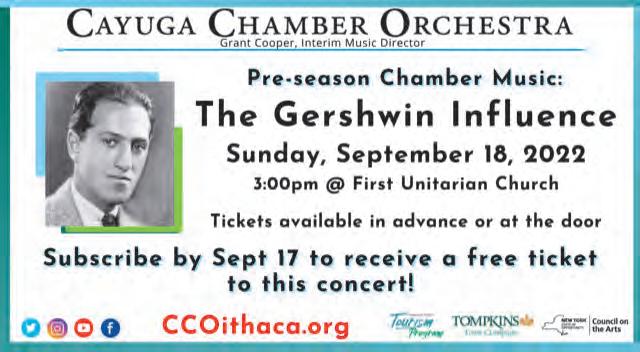




 By Lyndsey Honor
By Lyndsey Honor
“Do You Feel Anger,” written by Mara Nelson-Greenberg and currently playing at the Kitchen eatre, o ers a satirical look into today’s corporate world. rough the exploration of empathy, Nelson-Greenberg reveals the relationship between understanding feelings and nding one’s authentic self. She uses well-timed raunchy humor, strategic character development, and strong themes to narrate the events of the play.
“Do You Feel Anger?” opens by introducing So a, a young, optimistic woman. She’s an empathy coach who’s just started a new project at a debt collection agency. She was hired to shi the attitude and behavior of the company’s employees who have been having issues with their client calls. She quickly learns that these people can’t de ne emotions, let alone sympathize with others.

As the show progresses, So a nds herself trapped between sticking her ground and conforming to the sexist expectations of the establishment. Megan Rutherford’s costume design, speci cally for So a, strikingly re ects the character’s internal struggle and rapidly shi ing motivations. Simultaneously, M Berry’s lighting design—notably the use of ickering, orescent xtures—illustrates a similar escalation.
So a might be trying to help others understand their emotions, but her unwillingness to follow that advice becomes increasingly evident. How can the group learn empathy when their leader doesn’t model the expectation? e boiling point is certainly on the horizon.
e Kitchen eatre’s production, directed by Rebecca Bradshaw, moves quickly; it runs about 90 minutes without an intermission. e parallel structure of the scenes—following the general pattern of a voicemail to So a from her mother, a conversation between the characters So a and Jon, and a group exercise—helps the audience stay engaged with the plot’s fast pace.
Amoreena Wade’s So a attracts audience sympathy, while also making people question her intentions. Wade’s a natural
“Do You Feel Anger” explores the link between understanding feelings and finding one’s self. (Photo: Provided)
talent, and despite So a’s complexity, she brings the character to life e ortlessly.
As Eva, Elyse Steingold is vibrant, witty, and honest. Steingold’s delivery impressively lands with every line, and her performance demands attention.
While compelling on their own, Wade and Steingold complement each other well. e relationship between So a and Eva carries the true message of the play, and its executed beautifully in this production.

In other roles, Scott omas and Javier David Padilla—as Howie and Jordan respectively—steal the show with their command of stage and their comedic timing. Michael Samuel Kaplan manages to bring humility to the painfully unlikeable character of Jon, and though brief, Susannah Berryman appears as an eloquent Janie.
Berryman’s voice does get mu ed by the stereo when narrating as So a’s mother, but this doesn’t take away from the impact of the voicemail scenes.

As it turns out, emotions demand to be felt. Otherwise they’ll skyrocket, and fuses might get blown—physical and emotional. Empathy’s a ne art that requires practice, especially in settings where being vulnerable doesn’t feel particularly safe. Just give So a and the group a chance to prove this to you.
“Do You Feel Anger,” by Mara NelsonGreenberg, directed by Rebecca Bradshaw. At the Kitchen eatre, 417 West State St. Running September 6 through 25, times vary. Tickets at (607) 272-0570 or on the Kitchen eatre’s website: https:// www.kitchentheatre.org/doyoufeelanger

 By G. M. Burns
By G. M. Burns
Walk into any bookshop in this country and one can nd moving stories about the times young people are undergoing. But tricky times lead to interesting stories, and Ithaca native and Cornell alum Megan Shull goes beyond the daily angst with her sixth book, Billion Dollar Girl. is touching story digs deep into abuse, loneliness, homelessness, and hunger that many teens have undergone, and Shull is skilled and insightful as she weaves the heavy issues of today de ly while giving hope to young readers.
Ithaca Times: How did the story of Billion Dollar Girl come about for you, and what was hard for you during the writing of it?

Megan Shull: A lot of the book is anchored in my own unease with a popular culture that places an enormous value on fame, extreme wealth, beauty algorithms, and status. at, coupled with a growing disconnect from our natural world and each other, is having deleterious e ects on American kids and teens. In a lot of ways Billion Dollar Girl is my answer to all of that and, I hope, provides a soothing respite from the toxic stress too many vulnerable children and teens are living with.
In terms of what was hard—the sorrow of our world and complex problems we face as a human family bring about a lot of humility.
IT: What do you feel are the main themes / issues that are addressed in your book?
MS: is book is an exploration of who and what we value; poverty and privilege; trauma and repair; the interdependence of all living beings and our responsibilities to the air, the sea, the earth, and to each other.
IT: ere is a great focus in your books on understanding young people’s feelings and how they o en struggle. Can you talk about this and how you tap into this element in your recent story.

MS: Ka a said, a book is an ax for the frozen sea within us. I think all stories help us chip through the ice. In Billion Dollar Girl the protagonist, River Ryland is struggling in ways that are heartbreaking —the most of which is chronic neglect. She’s yearning for a sense of safety and predictable care. It’s only through a sense of safety and reliable care that we nd our own voice and power.
IT: Can you say how you decided to become a novelist?



MS: A er earning my doctorate from Cornell, I set out to help kids build resilience through stories. I love that books can provide a sense of attunement and connection and help kids—and all of us, really— feel seen and soothed and less alone. I love that books can help to validate painful emotions and be a safe haven in a storm. It’s a pretty fun job!
IT: Do you follow the old adage “Write what you know”?






MS: Hmm. I’d say I like to go toward what I’m most curious about and nd the right people to speak with in order to understand what I need to know to cra a story that works. I ask a lot of questions and interview people who share their knowledge and acumen with me. In an emotional sense —all those real and tender feelings that are in my books are what make us relate and connect with each other. e hardest things that we go through are o en what make us closer.
IT: What do you enjoy about being a writer?
MS: I love making stu . It’s a good feeling to make something from your heart and mind then: let it go.
Maddy Walsh- 2022 Summer Concert Series | 6 p.m. | Bernie Milton Pavilion, Center Commons
M13 | 6 p.m. | Hopshire Farm and Brewery | Free Friday Night Farm Jams: | 6:30 p.m. | Finger Lakes Cider
Red Oak Music Series - Tribal Revival | 12 p.m. | Lime Hollow Nature Center, 3277 Gracie Rd
Music & Mimosas at Hosmer Winery at Hosmer Winery | 1 p.m. Sunday Music Series | 1 p.m. | Red Newt Cellars, 3675 Tichenor Road | Free
Live music feat. Patrick Young | | Treleaven Wines, 658 Lake Road

Mondays with MAQ @ South Hill Cider | 5:30 p.m. | South Hill Cider, 550 Sandbank Road
Midday Music for Organ | 12:30 p.m. | Sage Chapel, Ho Plaza | Free
CCCP presents percussionist Greg Stuart | 7 p.m. | Milstein Hall Dome, 921 University Ave | Free
Cornell Biennial “A morning in 1953 (Messiaen Reversed, Birds Released)” by Joanna Malinowska and C.T. Jasper at Sibley Hall | 5 p.m.
Charis Dimaras Piano Studio Recital | 7 p.m. | Hockett Family Recital Hall, Gym Rd
Stephen Prutsman, piano: CU Music | 8 p.m. | Barnes Hall, 129 Ho Plaza | Free
Saturday Afternoon Music at Knapp Winery | 1 p.m. | Knapp Winery, 2770 Ernsberger Rd
Elective Recital: Kathryn Dauer, soprano | 2 p.m. | Hockett Family Recital Hall, Gym Rd
Elective Recital: Em Haak, voice | 4 p.m. | Hockett Family Recital Hall, Gym Rd
Glenn Tilbrook | 8 p.m. | Center for the Arts of Homer, 72 S Main St Rev. Robert Jones at the Conservatory | 8 p.m. | Trumansburg Conservatory of Fine Arts, 5 McLallen St | $15.00 - $20.00
Cornell Concert Series presents Sean Ardoin | 8 p.m. | Bailey Hall, 230 Garden Avenue
Junior Recital: Carolyn FitzGerald, trombone | 8:15 p.m. | Hockett Family Recital Hall, Gym Rd
Mr.Monkey | 9 p.m. | Moondance Restaurant, 2512 Cherry Valley Turnpike
Keyboard Recital By Dr. Thomas Donahue | 2 p.m. | Willard Chapel, 17 Nelson St
Founder’s Day Concert in the Park | 2 p.m. | DeWitt Park, N. Cayuga St. The Pursuit of Life, Liberty, and Love | 3 p.m. | Center for the Arts of Homer, 72 S Main St
Pre-season Chamber Music Concert: The Gershwin In uence | 3 p.m. | First Unitarian Church
Faculty Recital: Vadim Serebyany, piano | 4 p.m. | Hockett Family Recital Hall, Gym Rd
Composition Premieres at Hockett Family Recital Hall | 7 p.m. | Hockett Family Recital Hall, Gym Rd
CSMA Improv Class at Community School of Music and Arts | 4:30 p.m., 9/14 Wednesday | In this class students will learn the basics of improv in a low-pressure, supportive environment.
CSMA Storytelling Through Movement Class at Community School of Music and Arts | 6:30 p.m., 9/14 Wednesday | Movement can be expressive and freeing, but often we get stuck in the same ways of moving day in and day out.
Do You Feel Anger? at Kitchen Theatre | 7:30 p.m., 9/14 Wednesday
ComedyFLOPs 3rd Friday Improv Show To Support Loaves & Fishes | 7 p.m., 9/16 Friday | Virtual, https:// www.youtube.com/comedy ops | ComedyFLOPs’ 3rd Friday streaming Improv Shows in support of local area non-pro t organizations. This month
we’re supporting Loaves & Fishes! | Free

CSMA Self-Portrait Hand Puppets Class - Ages 6-9 at Community School of Music and Arts | 4:30 p.m., 9/20 Tuesday | Join us as we use clay, paint, fabric and styrofoam to create original hand puppets that look just like us!
Art Show: Two Pals Painting: Sharing a love of painting and the outdoors | 9:30 a.m., 9/14 Wednesday | Cortland Free Library, 32 Church St | Come see works by Sandra Cowan and Danielle Bellumori in the library’s gallery. This exhibit will be on display through August.
2022 Cornell Biennial Screening of “Gated Commune” by Camel Collective at Herbert F. Johnson Museum of Art | 10 a.m., 9/14 Wednesday | Johnson Museum of Art, 114 Central Avenue | Created by Anthony Graves (b. 1975, South Bend, IN) and Carla Herrera-Prats (b. 1973-d.
Visit the Exhibit Hall | 10 a.m., 9/14 Wednesday | The History Center in Tompkins County, 401 East State Street | Walk through local stories and discover the history of Tompkins County Open Hours Our Exhibit Hall is open Wednesday-Saturday 10am-5pm throughout the year.
Installation - Ken Feingold (artist) at Johnson Museum of Art at Herbert F. Johnson Museum of Art | 11 a.m., 9/14 Wednesday | As part of Cornell 2022 Biennial, artist Ken Feingold is exhibiting his installation that features interactive talking heads and AI-generated existential conversations.
2022 Cornell Biennial: Ken Feingold Installation | 11 a.m., 9/14 Wednesday | Johnson Museum of Art,
114 Central Avenue | Experience Ken Feingold’s new media installation, “The Animal, Vegetable, Mineralness of Everything,” at the Johnson Museum of Art from July 18 through October 21, 2022. | Free
2022 Ink Shop Member Show | 1 p.m., 9/14 Wednesday | The Ink Shop, 330 E. MLK/State St | Opening Reception 9/2. The Ink Shop launches a Member show annually giving our membership the opportunity to exhibit their newest work. | Free Ceramics: Jack-o-Lantern Luminaries | 6 p.m., 9/14 Wednesday | Pottery Works, 75 E. Court St | No Experience Necessary! Learn the fundamentals of hand building in this 2-Session Workshop while creating your own unique set of festive luminaries.
Passages at State Of The Art Gallery | 12 p.m., 9/15 Thursday | Artists: Eva Capobianco and Patricia Brown Show dates: September 1 to October 2. Opening reception Friday, September 2, 5-8 pm.
Pop In Studio Night | 4 p.m., 9/15 Thursday | Artist Alley at South Hill Business Campus, 950 Danby Road | Several artists studios and the gallery will be open to the public every third Thursday from 4-7pm.
2022 Cornell Biennial “At what point does the world unfold?” by Sara Jimenez at Goldwin Smith Hall | 9/15 Thursday | Cornell University, 144 East Ave | At what point does the world unfold? is a new installation by Sara Jimenez on Cornell University’s Arts Quad.
The Gallery at South Hill Exhibition of Nicholas Gecan’s “Love Your Mother” | 5 p.m., 9/16 Friday | The Gallery at South Hill, 950 Danby Road | The Gallery at South Hill presents Nicholas Gecan’s “Love Your Mother”. Based on Environmental Philosophy Nicholas Gecan’s paintings explore the spectrum of human involvement with the natural world.
| Free
Cornell Biennial “A morning in 1953 (Messiaen Reversed, Birds Released)” by Joanna Malinowska and C.T. Jasper at Sibley Hall | 5 p.m., 9/16 Friday | This project is based on Réveil des Oiseaux (Awakening of Birds), a composition for piano and orchestra by the legendary Modernist composer, Olivier Messiaen (19081982), which premiered in
Family Workshop: Snakes and Dragons with the Cornell Her-
petological Society | 10 a.m., 9/17 Saturday | Johnson Museum of Art, 114 Central Avenue | Meet members of the Cornell Herpetological Society and learn all about their snakes!
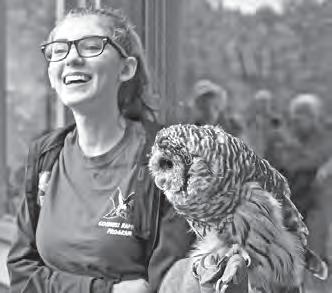
Military Vehicle Show | 10 a.m., 9/17 Saturday | Central NY Living History Center, 4386 US Route 11
| Military Vehicle Show at the CNY Living History Center in Cortland on Saturday, Sept. 17, 10 a.m. - 4 p.m. WWII, Korea, & Vietnam Era vehicles will be featured. | $5.00 - $10.00
Monarch Migration Celebration | 11 a.m., 9/17 Saturday | Cayuga Nature Center, 1420 Taughannock Blvd | With the classi cation of the monarch butter y as an endangered species, this event focuses on the conservation of Monarch butter ies through scienti c research and habitat preservation.
Join us for educational programs, seed-bomb making, and the opportunity to catch and tag monarchs. | Free
The Gallery at South Hill presents Nicholas Gecan’s “Love Your Mother” | 12 p.m., 9/17 Saturday
| The Gallery at South Hill, 950 Danby Road | The Gallery at South Hill presents Nicholas Gecan’s “Love Your Mother”. An exhibit focusing on environmental issues and human impact on nature. | Free
Desserts at Dusk at Hopshire Farm & Brewery | 6:30 p.m., 9/17 Saturday
| Join us for an evening of delicious dessert tastings, local libations, a unique silent auction, art gallery, online auction featuring original children’s literature illustrators, ra es, and
Ribbon Cutting for Mix Art Gallery and Revelry Yards | 10 a.m., 9/19

Monday | Please join the Tompkins Chamber, Downtown Ithaca Alliance, and City of Ithaca o cials for a ribbon cutting ceremony to celebrate the opening of two new businesses: Mix Art Gallery and Revelry | Free
CSMA Art and Art History for Teens at Community School of Music and Arts | 4:30 p.m., 9/20 Tuesday | Calling all teens interested in making art and looking at, thinking about, and engaging with contemporary and modern art!
September 16-22, 2022. Contact Cinemapolis for showtimes. New lms listed rst.*

The Silent Twins* | Based on the lives of June and Jennifer Gibbons, real-life identical twins who grew up in Wales and became known as “the silent twins” because of their refusal to communicate with anyone other than each other.| 113 mins R
Hold Me Tight* | A woman one day simply walks out on her family. Or does she?
| 95 mins NR
God’s Country*| When a college professor confronts two hunters she catches trespassing on her property, she’s drawn into an escalating battle of wills with catastrophic consequences.| 102 mins R
Pearl* | The story of how Pearl became the vicious killer seen in “X”.| 102 mins R
See How They Run* | In the West End of 1950s London, plans for a movie version of a smash-hit play come to an abrupt halt after a pivotal member of the crew is murdered.| 98 mins PG-13
Nope | Jordan Peele’s latest lm in which the residents of a lonely gulch in inland California bear witness to an uncanny and chilling discovery. | 135 mins R
All lms are shown at Willard Straight Hall on Cornell campus.
The Society of Spectacle | 9/14 at 7:00PM | An avant-garde essay lm in which Situationist thinker and political theorist Guy Debord uses a montage of lm clips and text to formulate a Marxist critique of capitalism, mass marketing, and consumer culture, inspired by his own landmark 1967 book of the same title.
Diva | 9/15 at 7:00pm; 9/16 at 9:00pm | An opera-intoxicated postman surreptitiously bootlegs a famous singer but nds himself in possession of another tape which is sought by the mob.
Blue Velvet | 9/15 at 9:30PM; 9/17 at 9:15pm | David Lynch’s classic thriller about sex, drugs, pain, and severed body parts.
Cane Fire | 9/16 at 7:00pm; 9/18 at 9:15pm | A kaleidoscopic documentary that considers the Hawaiian island of Kaua’i, from the escapist fantasies of Hollywood’s depiction to the harsh realities of colonialist oppression and environmental destruction that have shaped the life of its Indigenous population.
Dos Estaciones | 9/17 & 9/18 at 7:00pm | Fifty-year-old businesswoman María García is the owner of Dos
Estaciones, a once-majestic tequila factory now struggling to stay a oat as the last Mexican-owned plant in a business dominated by foreign corporations. When a persistent insect plague and an unexpected ood cause irreversible damage, María is forced to do everything she can to save her community’s primary economy and source of pride.
Cadejo Blanco | 9/21 at 7:00PM | w/ Filmmaker Justin Lerner ‘02 via Zoom.
A young woman, Sarita, plunges into Guatemala’s criminal underworld to seek the truth behind her sister’s mysterious disappearance.

Fall Foliage Eco-Cruise at Allen Treman State Park | 4:30 p.m., 9/15 Thursday | A relaxing afternoon cruise when the light is just right for leaf-peeping from the lake aboard the comfortable and spacious MV Teal.
Ithaca Night Bazaar at Steamboat Landing, Ithaca Farmers Market Pavilion | 6 p.m., 9/15 Thursday
| A monthly festival of musicians, makers, artists, performers, doers and dreamers.
New eld Fall Festival | 9 a.m., 9/17
Saturday | New eld United Methodist Church, 227 Main Street | Come to the
Fall Festival at the New eld United Methodist Church in New eld for family fun with crafters, a bake sale, luncheon, silent auction & face painting! | Free Migration Celebration | 10 a.m., 9/17 Saturday | Cornell Lab of Ornithology, 159 Sapsucker Woods Road | Visit the Migration Celebration at the Cornell Lab of Ornithology on Saturday, September 17, 10:00 am to 3:00 pm. It’s free! Enjoy workshops, exhibits, and activities focused on bird migration. | Free
O The Vine Festival | 10 a.m., 9/17 Saturday | Robert H. Treman State Park | You’re invited! Join us on September 17th at Robert H Treman State Park for the O The Vine Music Festival.
Moore Family Farm - Fall Festival & Teacher Appreciation Weekend | 10 a.m., 9/17 Saturday | Moore Family Farm, 570 Auburn Rd | Teacher Appreciation Weekend at Moore Family Farm. School Faculty & Sta receive FREE admission - 9/17 & 9/18. | $14.95 - $18.50
Ithaca Football vs Alfred University | 1 p.m., 9/17 Saturday | Butter eld Stadium | Ithaca Football vs Alfred Universityn https://athletics. ithaca.edu/calendar.aspx?id=18175
Ithaca Peace Festival at 309 Siena Drive | 6 p.m., 9/17 Saturday | Three day family friendly event to celebrate

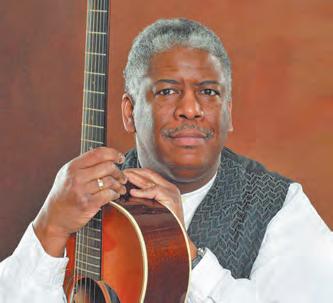
diversity, promote peace and build community relationahips while enjoying live music, international cuisine, chidlren’s activities and silent auction.
Streets Alive! Ithaca | 1 p.m., 9/18 Sunday | North Cayuga Street, North Cayuga Street | Streets Alive! Ithaca is a day where the streets are closed to cars and open to people to walk, bike, roll, dance, and play. Bike Walk Tompkins is thrilled to produce this magical festival every year and share the nearly endless creative possibilities that a car-free street can bring.
| Free
BYO for Food and Community Dye Bath at Streets Alive! | 1 p.m., 9/18 Sunday | Cayuga Stret by Thompson Park, north of Gimme! , North Cayuga Street | Join Zero Waste Ithaca at Streets Live! on Sun. 9/18 1-5p for Community Dye Bath! BYO (Bring Your Own) your old clothes and food containers, etc to save our environment. | Free Club Cayuga Sunset Cruises at Allen Treman State Park | 7:30 p.m., 9/18 Sunday | Club Cayuga Sunset Cruises feature lively music on board the MV Teal, operated by Discover Cayuga Lake, with some of our favorite local DJs!
Tween Book Club: Joey Pigza Swallowed the Key | 3:45 p.m., 9/14 Wednesday | Tompkins County Public Library, 101 East Green Street |
Ulysses Philomathic Library - Fall Book Sale | 5 p.m., 9/14 Wednesday
| Ulysses Philomathic Library, Main St | 9/14: Member Night ; Thursday & Friday, 9/15 & 16: All welcome!
TCSD classes will be enjoying library eld trips and free books from the children’s tent! Saturday, 9/17: UPL joins the libraries of Waterloo, Seneca Falls, Ovid, Lodi, and Interlaken for the “Between the Lakes Book Sale Trail.” Sweet Reads at the New eld Public Library | 6:30 p.m., 9/15 Thursday
| New eld Public Library, 198 Main Street | Join us Thursday, September 15, 6:30 pm. Let’s talk about the books we are reading over dessert! Visit https://new eldpubliclibrary.org/ sweet-reads-september-15/ for more info. | Free
Virtual Book Discussion: The Wild Edge of Sorrow by Francis Weller | 6 p.m., 9/16 Friday | Tompkins County Public Library, 101 East Green Street |


Constitution Writing (Leading @ IC) at Taughannock Falls Room, Campus Center | 4 p.m., 9/19 Monday | The purpose of this Constitution Writing workshop is to assist student organizations with writing or revising their constitution.
Virtual Panel by Panel Graphic Novel Book Club | 6:30 p.m., 9/19 Monday | Tompkins County Public Library, 101 East Green Street | Comic Book Club Meeting | 7 p.m., 9/20 Tuesday | Tompkins County Public Library, 101 East Green Street | Part 2 -- Famous Fan Clubs of the Marvel and DC Universes | Free
Knee High Story Time - Colors of the Rainbow | 9 a.m., 9/14 Wednesday | Phillips Free Library, 37 South Main Street | Welcome to Knee High Story Time - a program of stories, songs and more for toddler and preschool children and their family.
Science Together: Magnet Fishing | 10:30 a.m., 9/14 Wednesday | Sciencecenter, 601 1st Street | Wednesday, September 14, 10:30-11 am Go Fish!… with magnets! Science Together activities are designed for ages 0-4.
Tween Book Club: Joey Pigza Swallowed the Key | 3:45 p.m., 9/14 Wednesday | Tompkins County Public Library, 101 East Green Street |
FLIP IT Workshops | 5:30 p.m., 9/14 Wednesday | Edith B. Ford Memorial Library, 7169 Main Street | Join Family Educator, Joan Fi eld, for 6 free workshops in September that provide advice, strategies, and tools on how to address children’s day to day behavior. | Free
Preschool Art Session 1 | 3 p.m., 9/15 Thursday | Tompkins County Public Library, 101 East Green Street | Preschool Art Session 2 | 4 p.m., 9/15 Thursday | Tompkins County Public Library, 101 East Green Street | Groton Public Library Storytime at Groton Public Library | 6 p.m., 9/15 Thursday | Join the Library for a monthly storytime. This months theme is around The Winter Olympics.
Family Workshop: Snakes and Dragons with the Cornell Herpetological Society | 10 a.m., 9/17 Saturday | Johnson Museum of Art, 114 Central Avenue | Meet members of the Cornell Herpetological Society and learn all about their snakes!

We buy all cars! Junk, high-end, totaled – it doesn’t matter! Get free towing and same day cash! NEWER MODELS too! Call 866-535-9689 (AAN CAN)

Donate a car today! The benefits of donating your car or boat: Fast Free Pick-up - 24hr Response Tax Deduction - Easy To Do! Call 24/7: 855-9054755. (NYSCAN)
Wheels For Wishes benefiting Make-A-Wish Northeast New York. Your Car Donations Matter NOW More Than Ever! Free Vehicle Pick Up ANYWHERE. We Accept Most Vehicles Running or Not. 100% Tax Deductible. Minimal To No Human Contact. Call: (877) 798-9474. Car Donation Foundation dba Wheels For Wishes. www. wheelsforwishes.org. (NYSCAN)
Cherokee classic: with 4x4 automatic transmission, air cond., new muffler and tailpipe, radio and CD player, new tires with (300+-mi. use) new battery, tow hitch. Vehicle has 136,000 miles on the odometer. Vehicle has been routinely serviced by Ridge Road Imports in Lansing, NY. Price: $5,125. Ph. 607 280-9034.
BRIMFIELD IS HERE - ALL SHOWS! May 10-15, New shows open daily! BrimfieldAntiqueFleaMarket.com. 2022 Show Dates: May 10-15, July 12-17, September 5-10. (NYSCAN)
Buying antique dolls, doll parts, & early 1900s teddy bears. 607 429-9888.
DIRECTV for $79.99/mo for 12 months with CHOICE package. Watch your favorite live sports, news & entertainment anywhere. First 3 months of HBO Max, Cinemax, Showtime, Starz and Epix included! Directv is #1 in Customer Satisfaction (JD Power & Assoc.) Some restrictions apply. Call DIRECTV: 1-888-534-6918 (NYSCAN)
Bundy Rd. and Hopkins Rd. Saturday, September 10, 9:00 am - 2:00 pm Rain date: Sunday, September 11
TOP CA$H PAID FOR OLD GUITARS! 1920-1980 Gibson, Martin, Fender, Gretsch, Epiphone, Guild, Mosrite, Rickenbacker, Prairie State, D’Angelico, Stromberg. Gibson Mandolins & Banjos: 877-5890747. (AAN CAN)



Love what you do at Wegmans Food Market. 607-277-5800, Ithaca, 500 S. Meadow St., Ithaca, NY 14850

Satellite TV Service Starting at $74.99/month. Free Installation. 160+ channels available. Call Now to Get the Most Sports & Entertainment on TV! 877-310-2472 (ANN CAN)
4G
Get GotW3 with lighting fast speeds plus take your service with you when you travel! As low as $109.99/mo! 1-866-571-1325 (AAN CAN)



Updates in as little as ONE DAY! Affordable prices
- No payments for 18 months! Lifetime warranty & professional installs. Senior and Military Discounts available. Call: 1-266-370-2939 (AAN CAN)
With 2 Year Price Guarantee! $59.99/mo with 190 channels and 3 months free premium movie channels! Free next day installation! Call 888-5085313 (NYSCAN)
Single Ch 7 Bankruptcy $599 Legal Fee
Res Real Estate Closing $599 Legal Fee Auto Accident, Slip Fall Injury, Wills Mark Gugino 144 Bald Hill Danby NY Bk@twcny.rr.com or 607-207-0888
Attorney Advertising Debt Relief
PAYING TOP CA$H FOR MEN’S SPORT WATCHES! Rolex, Breitling, Omega, Patek Philippe, Heuer, Daytona, GMT, Submariner and Speedmaster. Call 888-320-1052 (ANN CAN)

Full-time year-round PAINTERS. Competitive wages. PTO. 401k matching. Experience preferred, not required. Apply 607-423-3275 or ERNZCOPAINTING.com
Gene’s Barber Stylist is currently looking for a licensed, talented and friendly barber or stylist to rent a chair. Be a part of a busy and established barbershop with a great location and parking. Rental days available are Friday, Saturday and Sunday which are our busiest days. Call Jen 607 342-6820 for more details.
Property Management Operations Specialist. Travis Hyde Properties, Ithaca, NY. Assist in event planning, facilities mgmt. accts. recelvable & customer svc Req’d: Associate’s deg., exp. in closing commercial & residential real estate sales & some travel in Ithaca area. Proficient in Power Bl, Yardi, Adobe & MS Office Suite. Please send resumes to ehyde@travishyde.com

For 190 channels + $14.95 high speed internet. Free Installation, Smart HD DVR included. Voice Remote included. 1-866-566-1815 , expires 1/21/23 (AAN CAN)
Reduce
$64.99 For 190 Channels + $14.95 High Speed Internet. Free Installation, Smart HD DVR Included, Free Voice Remote. Some restrictions apply. Promo EXPIRES: 1/21/23, 1-888-609-9405 (NYSCAN)
ARE YOU BEHIND $10K OR MORE ON YOUR TAXES? Stop wage & bank levies, liens & audits, unfiled tax returns, payroll issues, & resolve tax debt FAST. Call 888-869-5361 (hours: Mon-Fri 7am-5pm PST) (NYSCAN)
Eliminate gutter cleaning forever! LeafFilter, the most advanced debris-blocking gutter protection. Schedule a FREE LeafFilter estimate today. 15% off and 0% financing for those who qualify. PLUS Senior & Military Discounts. Call 1-877-763-2379. (NYSCAN)
Never Pay For Covered Home Repairs Again! Complete Care Home Warranty COVERS ALL MAJOR SYSTEMS AND APPLIANCES. 30 DAY RISK FREE. $200.00 OFF + 2 FREE Months! 1-866-440-6501 (NYSCAN)

Spectrum Internet as low as $29.99, call to see if you qualify for ACP and free internet. No Credit Check! Call Now! 833-955-0905 (ANN CAN)

Home IT/home automation support services. come to you to help with new projects, or to sort out pesky gadget configuration issues with PCs laptops, printers that won’t print, Alexa (connecting to power strips, lights, doorbells, locks, AC etc), poor or intermittent wi-fi, networking issues, NAS devices etc. www.graybeardgeek.org


TRAIN ONLINE TO DO MEDICAL BILLING! Become a Medical Office Professional online at CTI! Get Trained, Certified & ready to work in months! Call 855-543-6440. (M-F 8am-6pm ET) Computer with internet is required. (NYSCAN)


Become a Medical Office Professional online at CTI! Get Trained, Certified & ready to work in months! call 866-243-5931 (M-F 8am-6pm ET) Computer and internet is required.(AANCAN)


Never clean your gutters again! Affordable, professionally installed gutter guards protect your gutters and home from debris and leaves forever! For a FREE Quote call: 844-499-0277 (ANN CAN) OWE

For Learning, Activities, Social Groups And More! For Adults 50+ Lifelong 119 West Court St., Ithaca 607-273-1511 tclifelong.org
AAM
ALL ABOUT MACS
Macintosh Consulting http://www.allaboutmacs.com (607) 280-4729
LAND & SEA FingerLakesAnimalRights.org
Ithaca City School District 150 Bostwick Rd, Ithaca 607-274-2128
4 to 1 Student to Faculty Ratio 607-272-3110
CLEANING SERVICES
RESIDENTIAL & COMMERCIAL JANITORIAL* FLOOR * CARPET INDEPENDENCE CLEANERS CORP 607-227-3025 / 607-697-3294
For rates and information contact front@ithactimes.com 277-7000

Are you or someone in your home suffering from Allergy or Asthma? Have your heating ducts cleaned to remove Dust, Fungi, Mites, Lint & Sout. Do now before heating season starts. ANCHEATING.COM (607) 273-1009
Everyone Is Welcome Shop at the COOP
Full Service Grocery Store GREENSTAR FOOD CO+OP 770 Cascadilla St., Ithaca
FLYITHACA.COM Convenient-Clean-Connected
Get The New Ithaca Times Mobile App Available in Appstore & Google Play
ITHACA NEWS
Delivered to your inbox every day Ithaca Times Daily Text ITHACA to 22828 to Sign up
ITHACA TAX SERVICE
Qualified, Competent, Caring 25 Years Experience Licensed Enrolled Agent of the IRS 607-339-0532
WE ARE HIRING VISIT US ONLINE www.wgaforchildren.org or call 607-844-6460
THE WILLIAM GEORGE AGENCY
Looking to Boost your Fall Business
Call Larry at 607-277-7000 ext: 1214
Find out about great advertising ad packages at: Ithaca.com & Ithaca Times
Men’s and Women’s Alterations for over 20 years Fur & Leather repair, zipper repair.
Same Day Service Available
John’s Tailor Shop
John Serferlis - Tailor 102 The Commons 273-3192
New, Used & Vintage Instruments & Accessories ITHACA GUITAR WORKS DEWITT MALL 607-272-2602
No Long waits for Dermatology Appointments Finger Lakes Dermatology Brad Yentzer, MD, FAAD 607-708-1330 fingerlakesderm.com
** Peaceful Spirit Tai Chi ** Yang style all levels Fridays 6-7 pm at NY Friends House 120 3rd St., Ithaca 607-272-0114
Rebuilt, Reconditioned, Bought, Sold, Moved Tuned, Rented Complete Rebuilding Services No job too big or too small
Ithaca Piano Rebuilders (607) 272-6547 950 Danby Rd, Suite 26 South Hill Business Campus, Ithaca
READY FOR WINTER?
Upgrade your home with replacement windows, we manufacture and install. SOUTH SENECA VINYL 315-585-6050
REAL LIFE CEREMONIES
Every life story deserves to be told, and told well. Steve Lawrence, Celebrant 607-564-7149
WEGMANS FOOD MARKET NOW HIRING 607- 277-5800 500 S. Meadow St., Ithaca JOB.WEGMANS.COM
The only dedicated retail store for all the CBD 308 E. Seneca St * Ithaca 845-244-0868